


The 9th Asian Winter Games is being held in Harbin, capital city of Northeast China's Heilongjiang province from Feb 7 to 14.
Over 1,200 athletes from 34 countries and regions across Asia compete in the Games, making this edition the largest in terms of participating delegations and athletes.
With the highly-anticipated continental sports gala set to celebrate its official opening with a grand ceremony on Friday, Winter Asiad — the official English publication of the 9th Asian Winter Games — was launched on Wednesday.
Designed and published by China Daily, Winter Asiad features competition highlights, touching stories from on and off the field, and a behind-the-scenes look at the efforts of the organizing committee to deliver a spectacular tournament.
China Daily has been the designer and publisher of the official English journals of many major international sports events, including the 2022 Beijing Winter Olympics and 2008 Beijing Summer Olympics, as well as multiple Asian Games.
BEIJING -- President Xi Jinping will attend the opening ceremony of the 9th Asian Winter Games, which will be held on Friday in Harbin, Northeast China's Heilongjiang province.
The top leader will also declare the Games open.
Xi will host a welcome banquet for foreign leaders attending the opening ceremony, including Sultan of Brunei Haji Hassanal Bolkiah Mu'izzaddin Waddaulah, Kyrgyz President Sadyr Japarov, Pakistani President Asif Ali Zardari, Prime Minister of Thailand Paetongtarn Shinawatra, and National Assembly Speaker of the Republic of Korea Woo Won-shik.
The opening ceremony will be broadcast live by China Media Group. Xinhuanet will provide live coverage with photos and text updates.
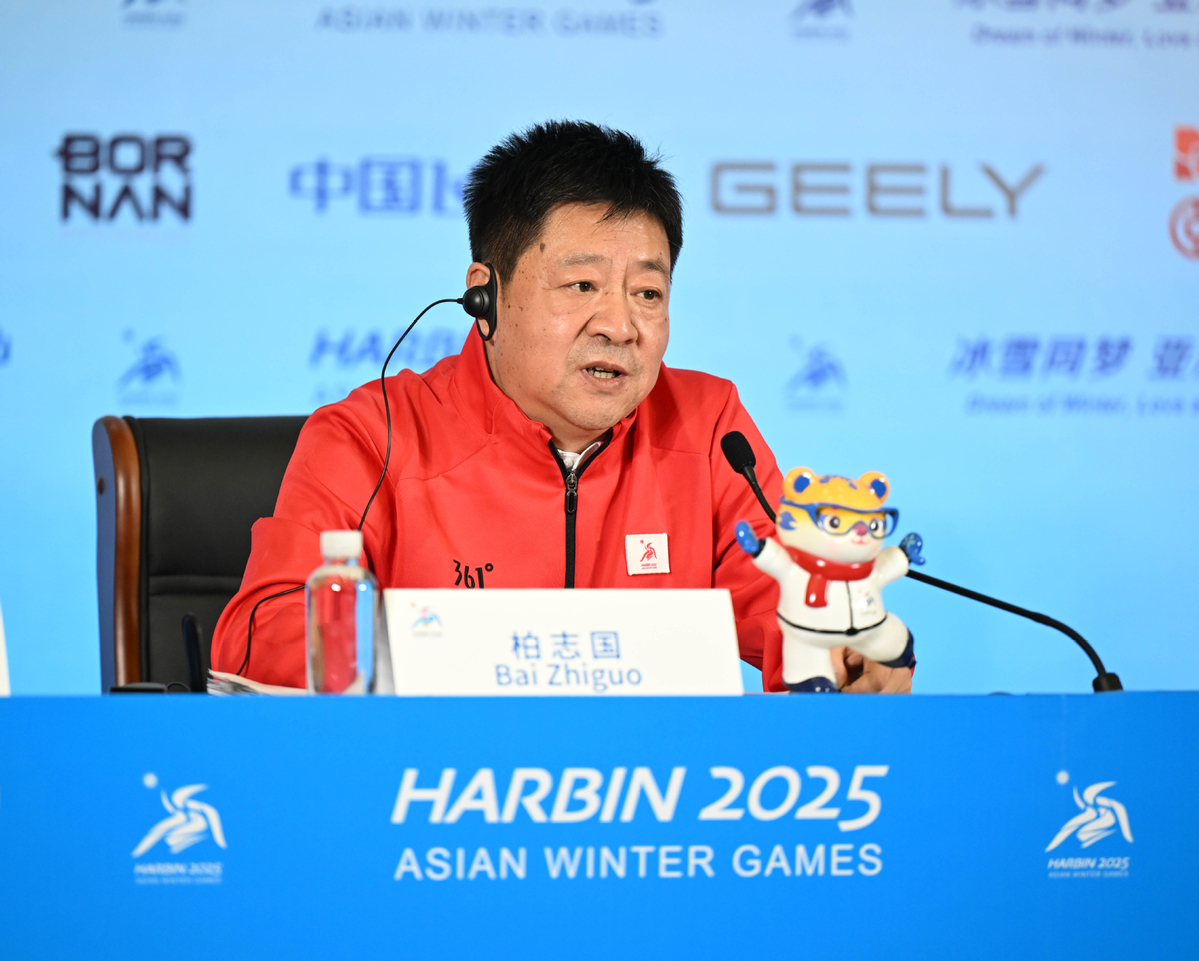
All preparations for the opening ceremony of the 9th Asian Winter Games are fully ready, said the organizing committee on Thursday.
The Games will be held from Feb 7 to 14.
"After more than 10 full-process rehearsals and three full-element drills, the music, videos, special effects, program arrangements, and overall coordination of the ceremony have been optimized," Bai Zhiguo, a deputy secretary-general of the organizing committee and the chief spokesperson, said at a news conference in Harbin, Heilongjiang province, on Thursday. "We have arranged 50 etiquette personnel and over 600 volunteers inside the venue to provide services to audience members in need."
For transportation services, around 300 support vehicles will be provided to offer collective transportation services from hotels to the opening ceremony venue for various participants, and high-speed rail special trains will be provided for those attending the opening ceremony from Yabuli, the ski resort cluster hosting the snow sports at the Games.
"A professional medical team has been established, with 2 medical rooms, 4 medical stations, and 8 audience medical points set up to cover the entire venue, equipped with emergency-related ambulances, stretchers, medicines, and equipment," said Bai. "A green channel for medical treatment has been opened at designated hospitals."
According to Zhou Wei, deputy director of the committee's ceremonies and events department, the total planned duration of the opening ceremony is about 80 minutes.
"As this year's Games will see the largest representation of Asian countries and regions in history, there will be representatives from 34 countries and regions across Asia parade during the opening ceremony to showcase their elegance to the world," said Zhou. "In a creative approach, the opening ceremony combines the main venue with a secondary venue - the main venue is set at the Harbin International Convention and Exhibition Sports Center, while the secondary venue is located at the renowned Harbin Ice and Snow World, the largest ice and snow theme park in the world."
"This winter, the Harbin Ice and Snow World has specially designed a themed ice and snow park featuring representative buildings from Asian countries and regions, which will be synchronized with the performances at the main venue to evoke empathy and resonance among the people of Asia."
"Particularly, the highly creative and distinctive torch lighting ceremony is expected to astonish the world," he said.
Furthermore, the cultural performances at the opening ceremony make full use of advanced technological means to create a visually stunning experience, such as virtual and augmented reality, glasses-free 3D technology, digital AI, and other visual effects.
Along with equipment such as facade screens, digital ground screens, and light art projection screens, the ceremony must create an immersive panoramic space, Zhou added.
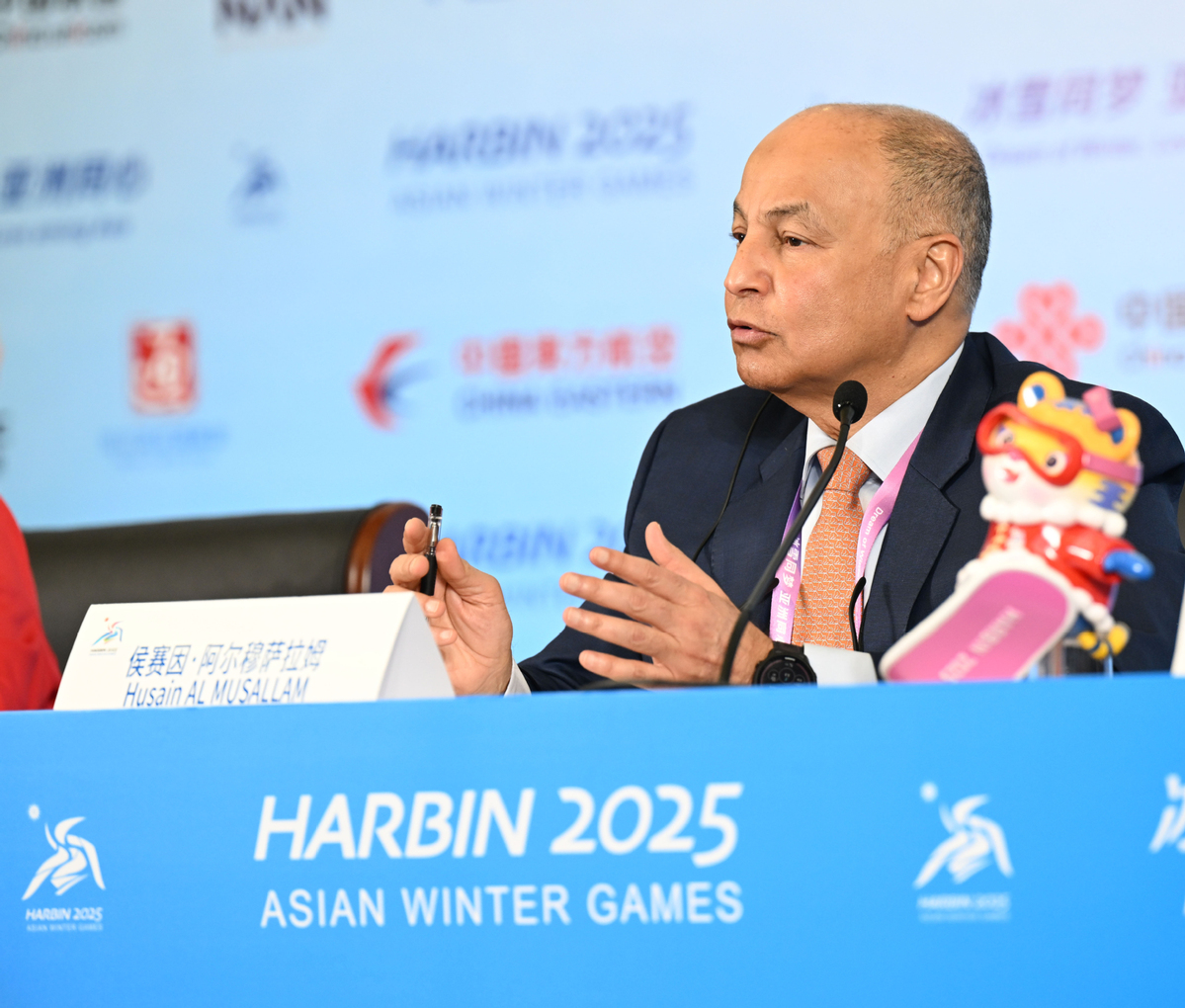
HARBIN - The 9th Asian Winter Games in Harbin will unite people again in sports against all odds to further promote the Asian Olympic movement, said Husain Al Musallam, director general of the Olympic Council of Asia (OCA).
Since winning the bid for the Games in July 2023, Harbin's preparations have been in full swing. According to the organizers, over 1,200 athletes from 34 countries and regions across Asia will compete, making this edition the largest in terms of participating delegations and athletes.
"Harbin did a great job after taking the Games two years ago. The organizers prepared the facilities here and all the Games' requirements in a very short time and in a very professional way," said Al Musallam, expressing his belief that the Harbin Asian Winter Games, themed "Dream of Winter, Love among Asia," can unite people in sports regardless of the conflicts and uncertainties in the world.
He added, "The Harbin Asian Winter Games will be a platform for Asian athletes to get the qualifications for the Winter Olympics in different sports, which will prepare Asian athletes to perform and compete in a high standard for the Milan-Cortina 2026 Olympic Winter Games."
Since the first edition of the Asian Winter Games in Sapporo in 1986, winter sports have been developing rapidly in Asia with wide public participation. "We are pleased that winter sports have become very popular in Asia, from the north and east to the south and west," Al Musallam remarked.
The 2029 Asian Winter Games will be held in Trojena of Saudi Arabia, marking the first time it is held in West Asia. "The Games to be held in Saudi Arabia will increase the popularity of winter sports, which will be one of the main attractions for tourism," Al Musallam noted.
Al Musallam was also impressed with the development of sports over decades, from the Beijing 1990 Asian Games to the Hangzhou Asiad in 2023, stating, "Everybody witnessed the new technologies utilized at the Hangzhou Asian Games."
Technologies including virtual reality and augmented reality will also be applied for Friday's opening ceremony of the Harbin Asian Winter Games.
The organizers revealed that, besides the main venue at the Harbin International Conference, Exhibition and Sports Center, there will be a branch venue for the opening ceremony at the Harbin Ice-Snow World, the world's largest ice-and-snow theme park.
To welcome the upcoming 9th Asian Winter Games, the host city of Harbin has been adorned with decorative elements that embody profound Chinese culture, the dynamics of winter sports and the gala event's theme.
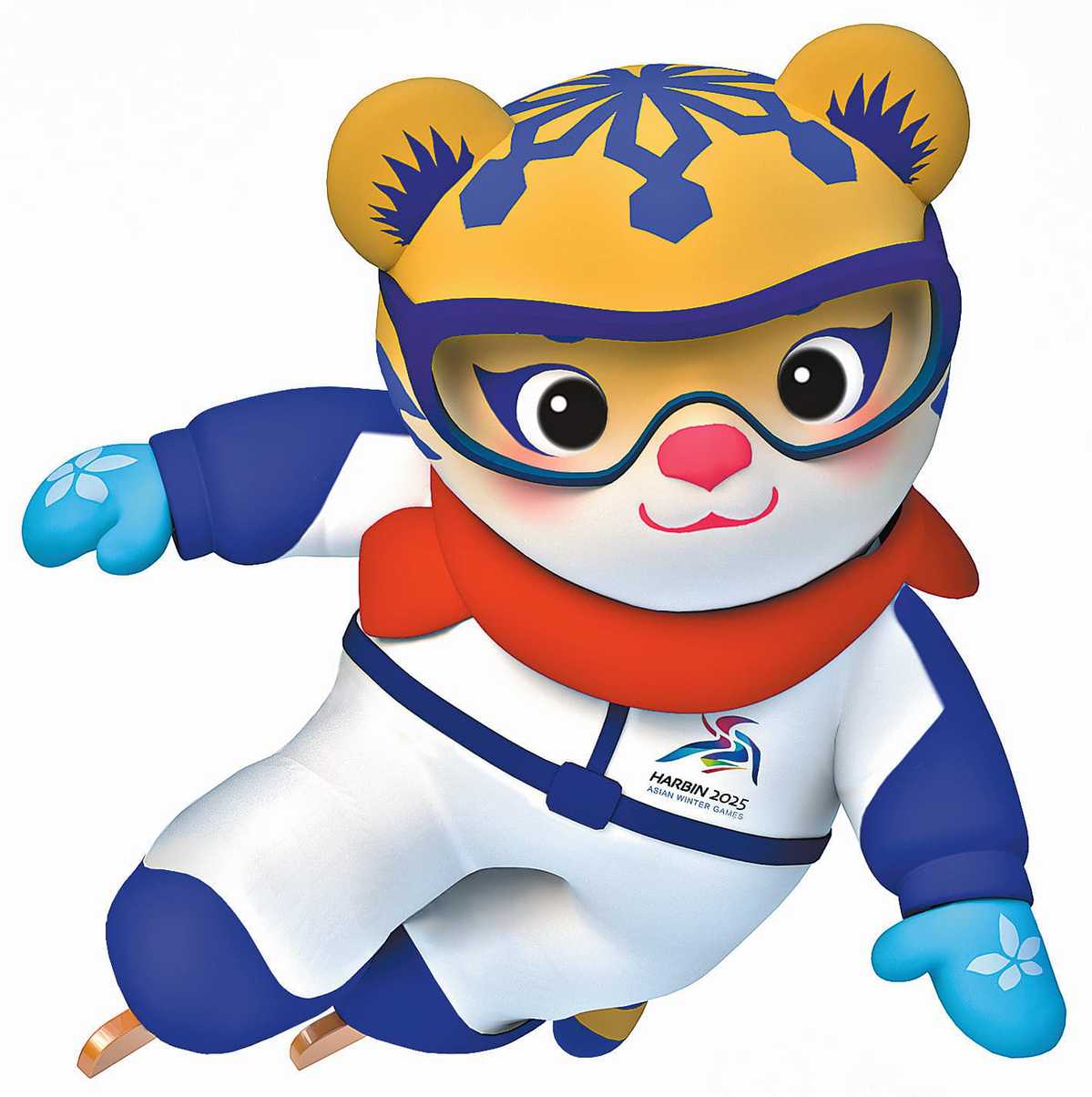
Mascots
The mascots of the 9th Asian Winter Games — Siberian tigers "Binbin" and "Nini" — symbolize an in-depth exploration and shaping of the unique natural and cultural heritage of the country's Northeast: Siberian tiger culture.
"The archetypes of Binbin and Nini are two cute little Siberian tigers born in September 2023 at the Siberian Tiger Park in Harbin," said Zhang Qixiang, vice-governor of Heilongjiang province.

"We pondered what kind of mascots could encapsulate the rich history and contemporary flair of Harbin, along with the warmth, honesty and romance of its people. We then considered the Siberian tiger, with its three-million-year evolution. A symbol of nature's harmony in Heilongjiang, it embodies both power and playful charm," explained the chief designer Chen Lei, who is also head of the department of visual communication design at the Academy of Arts and Design at Tsinghua University.
In Chinese culture, the tiger symbolizes good luck, and embodies qualities such as integrity, strength, and courage, all in line with the spirit of the continental sporting gala.
Binbin represents the ice events as he shows off his winter sportswear and shares his joy of ice dancing, while Nini represents the snow events, wearing traditional Chinese clothes.
The mascots' features are inspired by cloth tiger toy designs and the visual language of traditional paper-cutting art from Harbin. Their forehead patterns are shaped to look like snowflakes, while the flower pattern on their gloves represents the lilac, Harbin's city flower.

Medals
The medals for the Asian Winter Games, titled "Spirit of Speed", signify an event brimming with energy, showcasing the fervor and zeal for winter sports alongside the unity and friendship among Asian countries.
The design on the front of the medals combines the streamlined shape of a racetrack with the emblem of the 9th Asian Winter Games, capturing the powerful and graceful motion of athletes in action. This design embodies the strength and beauty of competitive sports. The flowing curves of the racetrack incorporate the silhouette of the Harbin Grand Theatre, reflecting the city's unique aesthetic.

The reverse side of the medal features a picturesque landscape of Yabuli, with mountain ranges and forests that mirror the terrain of the Greater and Lesser Hinggan Mountains, creating a vibrant portrayal of Heilongjiang's rich and bountiful landscape.
At the center, the emblem of the Olympic Council of Asia is embedded with a rare Xunke red agate from Heilongjiang — symbolizing the sun shining brightly over the vibrant land.
"Xunke red agate boasts high transparency, a soft and lustrous sheen, and a smooth surface. These unique qualities can enhance the medals with a distinctive visual effect and aesthetic appeal," said Zou Cunliang, the medals' chief designer.
It is also a locally sourced gem from Heilongjiang province. By incorporating it into the design of the medals, it can fully embody the regional cultural characteristics of the host, attracting people from various parts of Asia to better understand the cultural heritage of Heilongjiang, he added.
The ribbon clasp at the top of the medals is inspired by the Sun Gate of Sun Island scenic area in Harbin, another feature that embraces the characteristics of the host city.

Torch
The Games' torch, which takes the form of a blossoming lilac, stands at a height of 735 millimeters, with a diameter at the crown of 115 mm and a grip diameter of 50 mm.
It features colors such as China red, lilac purple and snow white. The outer edge of the torch's combustion chamber is adorned with a cutout snowflake pattern.
When ignited, the torch presents a harmonious blend of ice and fire, highlighting the brilliance and passion of winter sports.
The torch design is further inspired by the Heilongjiang River that flows through its namesake province.
Zhang Junhai, the designer of the torch, and an industrial design teacher from Beijing University of Science and Technology, explained: "I designed the entire torch around the concept of the surging power of water, in a majestic and powerful manner. Therefore, the torch's shape grows upwards from the bottom."
The design theme — "surging" — aims to embody the lively and dynamic energy of nature, symbolizing the vibrancy and passion of the 9th Asian Winter Games.

Emblem
The emblem, titled "Breakthrough", combines elements of a short-track speed skater's sprinting posture, a lilac and the glowing red sun of the Olympic Council of Asia, blending Chinese culture with Olympic elements. It conveys China's pursuit in the new era of accelerating the development of a strong sporting nation, and tirelessly striving for higher, faster and stronger goals, contributing to the development of winter sports in Asia.
With a gradient of blue and purple hues, the emblem captures the iridescent play of light on ice, symbolizing the enchantment of winter sports. The purple gradient in the ribbon, again draws from the lilac.
The emblem's design is reminiscent of the Chinese character for "nine" — jiu — a number signifying prestige and authority in Chinese culture. The pattern seeks to reflect Harbin's profound respect for other Asian countries.
Furthermore, the emblem's outer contours form a calligraphic Chinese character he, which translates to "combination", symbolizing the Chinese people's aspiration to gather with friends from across Asia, foster unity, collaborate and progress together.
Contact the writer at [email protected]
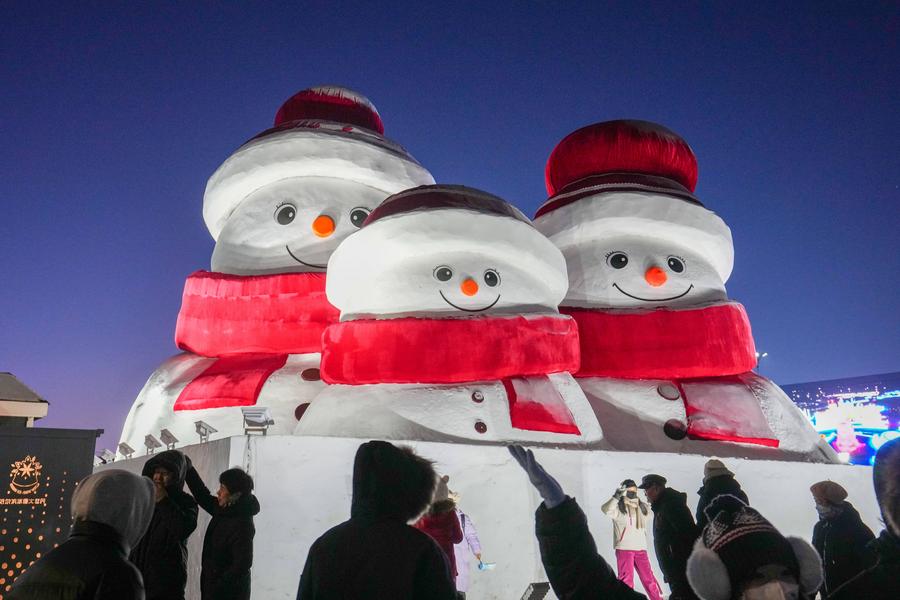
Renowned worldwide for its unique ice and snow culture, Harbin, capital city of Northeast China's Heilongjiang province, attracts a multitude of visitors every year to its ice and snow world, with the biggest draw being the spectacular ice sculptures.
Between late December and February, the streets, parks and squares in the city are transformed into magnificent stages for fantastic ice and snow sculptures of people, legendary figures, animals and abstract patterns.
These creations not only demonstrate the exquisite skills of the people of Harbin, but also convey their aspirations and pursuit of a better life.
The origin of Harbin's ice sculptures can be traced back to the 1960s, when a group of local artists and enthusiasts, who were passionate about ice and snow art, began harvesting ice from the frozen Songhua River and crafted detailed and beautiful winter masterpieces.
After decades of development and evolution, Harbin's ice sculptures have become the jewel in the crown of Chinese ice and snow culture, serving as an indispensable cultural emblem of the city. Meanwhile, the ice sculptors have developed a unique skill set and style through practice and experimentation. They use high-quality natural ice blocks, and employ techniques, such as carving, polishing and coloring, to transform them into exquisite works of art.
During the production process, ice sculptors, who master a rich set of carving techniques and a knowledge of color coordination, can adeptly utilize various carving tools to sculpt ice into different shapes and patterns. Their color coordination techniques make these works even more vivid and realistic.
Harbin's ice sculptures hold significant cultural value, reflecting various aspects of the history, culture and folklore of the northeastern region. Furthermore, the sculptures serve as a bridge for cultural exchanges between China and the world. During the season, the city has held a series of events to promote winter tourism. In addition to the Harbin Ice and Snow World, many other winter-themed attractions have been established to entice visitors.
Wearing a red scarf, a red hat and a smiling face, a giant snowman had been erected in the Qunli Music Park.
At the Sophia Square, and on Central Street, 10 adorable penguins from Harbin Polarpark have waddled to greet tourists.
At the Sun Island scenic area, an imposing 20-meter-tall snow sculpture featuring Sun Wukong, the Monkey King, has debuted at the 37th Harbin Sun Island International Snow Sculpture Art Expo.
Contact the writers at [email protected]
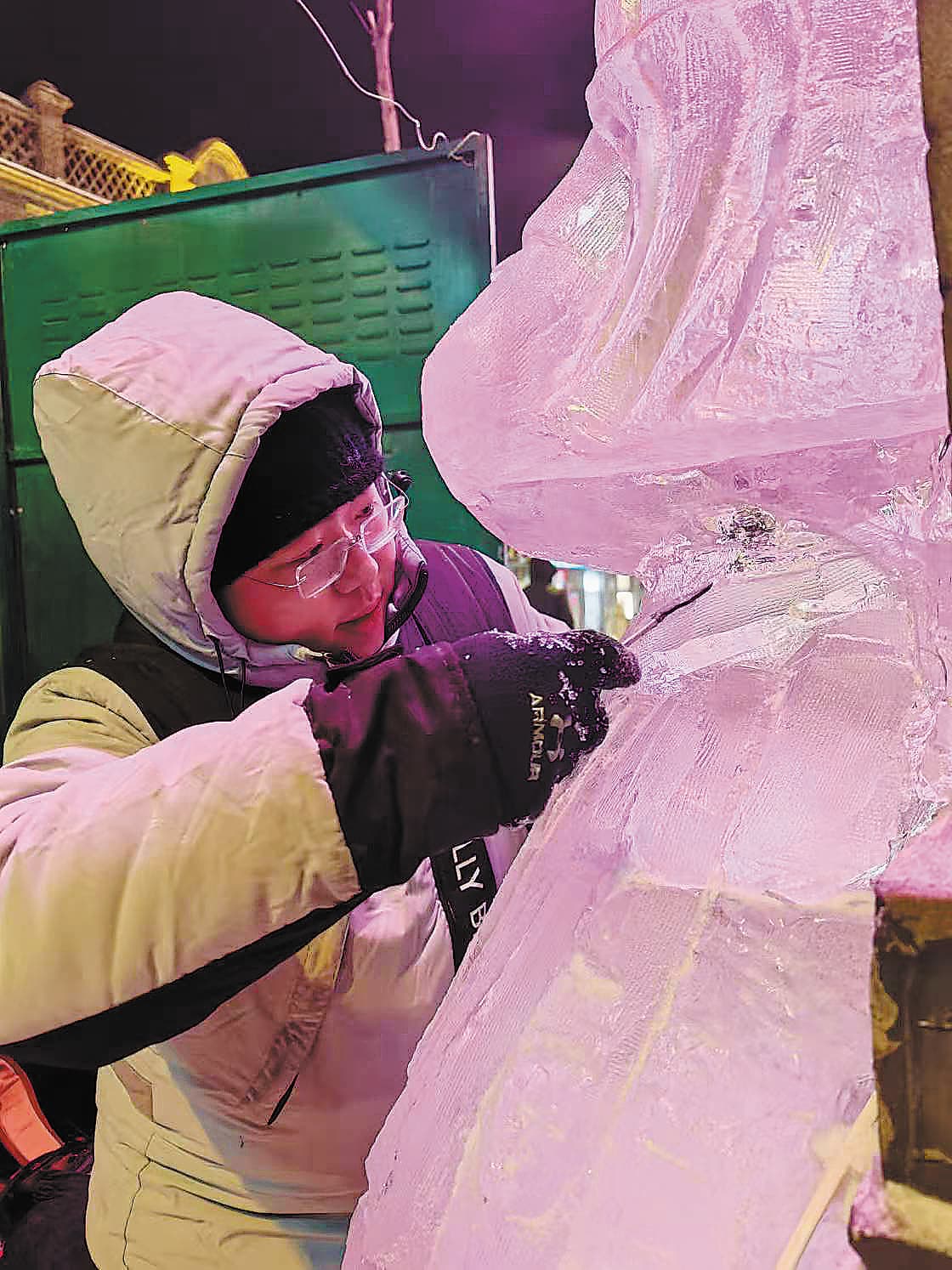
In the bitter chill of winter, a group of ice sculptors in Harbin, Heilongjiang province, chisel and carve plain blocks of ice into exquisite works of art.
One of those sculptors, Xu Haonan, has spent eight years practicing ice sculpture, an art form he has been involved with since his childhood.
"The first ice lantern I ever saw was made by my grandfather. I witnessed the process of him freezing a few pieces of colored paper in a small bucket and tying it to a wooden stick with a rope," said Xu, who was born in 1998.
"During the Lantern Festival when I was six years old, I really wanted to buy a lantern like every other child, but the financial situation of my family wouldn't allow for it," he said.
"That's why my grandfather managed to freeze an ice lantern for me using a water bucket," he said. "I loved it so much, and I still remember its appearance."
Xu lived near the Songhua River, and often saw workers collecting ice blocks from the frozen watercourse in the winter.
"At that time, I was curious, and imagined that, one day, I could create such works," he said. "So I chose public art as my major when I entered Harbin University in 2016. I also participated in various ice sculpture competitions, winning several national and international medals."
After graduation in 2020, Xu tried different jobs, such as art teacher and designer.
"At every interview, I would ask the company whether I could have three months away every winter to work on ice sculptures in Harbin," he said. "So, I missed out on a lot of good jobs."
In December 2023, Xu established his studio, focusing on ice carvings and, in early 2024, he became design director at a creative cultural company in Beihai, Guangxi Zhuang autonomous region.
"The process of ice carving is not easy," he said. "From design, material selection and carving, to the final polishing, each step requires a significant amount of time and effort."
"Especially in the cold, working outdoors for long periods is a great test of an ice sculptor's physical strength and willpower," he added.
The ice sculptures in Harbin are all hewn from natural raw materials.
On the frozen Songhua River, which runs through Harbin, workers near the riverbank use a chain saw to cut blocks to the required size.
"After receiving the ice blocks, carving usually begins around 7 am. I often work outdoors for 10 hours a day, but I enjoy every single minute."
Xu and his team are renowned for creating exquisite, small sculptures.
"We do not aim for the grand impact of large ice sculptures, but rather focus on the refined details of the works, such as the textures," he said. "Sometimes, the sculpting process becomes part of the attraction for tourists to observe."
"Furthermore, ice sculptures in Harbin keep up with the times. Instead of being limited to traditional subjects, such as the 12 animals of the Chinese Zodiac, they embrace popular IPs, or more modern subjects. Ice sculptors work based on current trends, seeking a blend of tradition and modernity, technology and future changes."
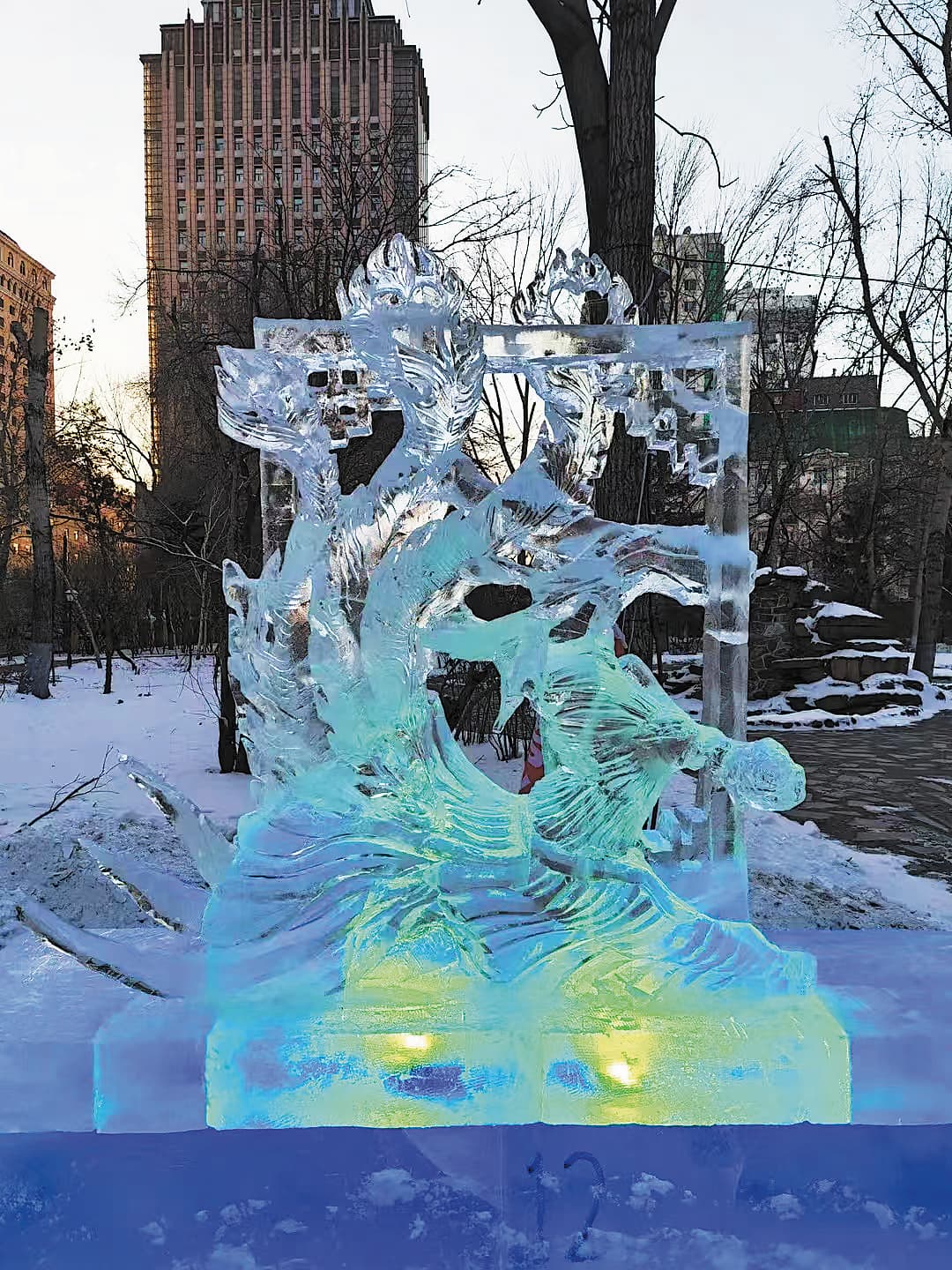
Due to long hours working in the cold, many ice sculptors develop bad backs and shoulders.
"Although I'm only 26 years old, I suffer from severe lumbar disc herniation," he said.
"As older generations of ice sculptors gradually retire due to age and for health reasons, the ice carving industry is facing a shortage of talent."
"There are about 10,000 people in Harbin engaged in the ice carving industry, including ice and snow architects, but less than 1,000 people are proficient in ice carving techniques."
"I hope more young people will come to understand and appreciate ice carving, and be willing to join the industry," he added.
With the continuous development of the ice and snow economy in the country, tourism in Harbin is booming.
"While I was in Guangxi, my customers were excited to hear that I could create ice sculptures, and eagerly listened to my explanations about ice carving and the customs of Harbin," he said.
So far, Xu has created over 100 ice sculptures.
"This winter, Harbin is still eagerly anticipating the arrival of tourists, especially with the upcoming Asian Winter Games," he said. "Our ice carving orders have increased by around 20 percent compared to previous years."
"I hope to create more beautiful ice sculptures to provide visitors with even more wonderful visual experiences," he said. "I also hope to contribute to the healthy development and inheritance of the ice carving industry."
ZHOU HUIYING and TIAN XUEFEI in Harbin

The world's largest ice and snow theme park — Harbin Ice and Snow World
The 26th Harbin Ice and Snow World covers a total area of 1 million square meters and uses 300,000 cubic meters of ice and snow. The park replicates iconic landmarks from the 45 countries and regions of the Olympic Council of Asia in ice and snow. It attracted over 1 million visitors in the first 20 days following its official opening on Dec 21.

Asia's largest outdoor public ice rink — Harbin New Area Outdoor Ice Sports Center
Spanning 800,000 sq m, the Harbin New Area Outdoor Ice Sports Center is currently the largest outdoor public ice rink in Asia, featuring the most comprehensive ice sports and athletic facilities.
Beyond ice skating, the venue also hosts ice tug-of-war, snow football, ice obstacle courses, ice bowling and curling.
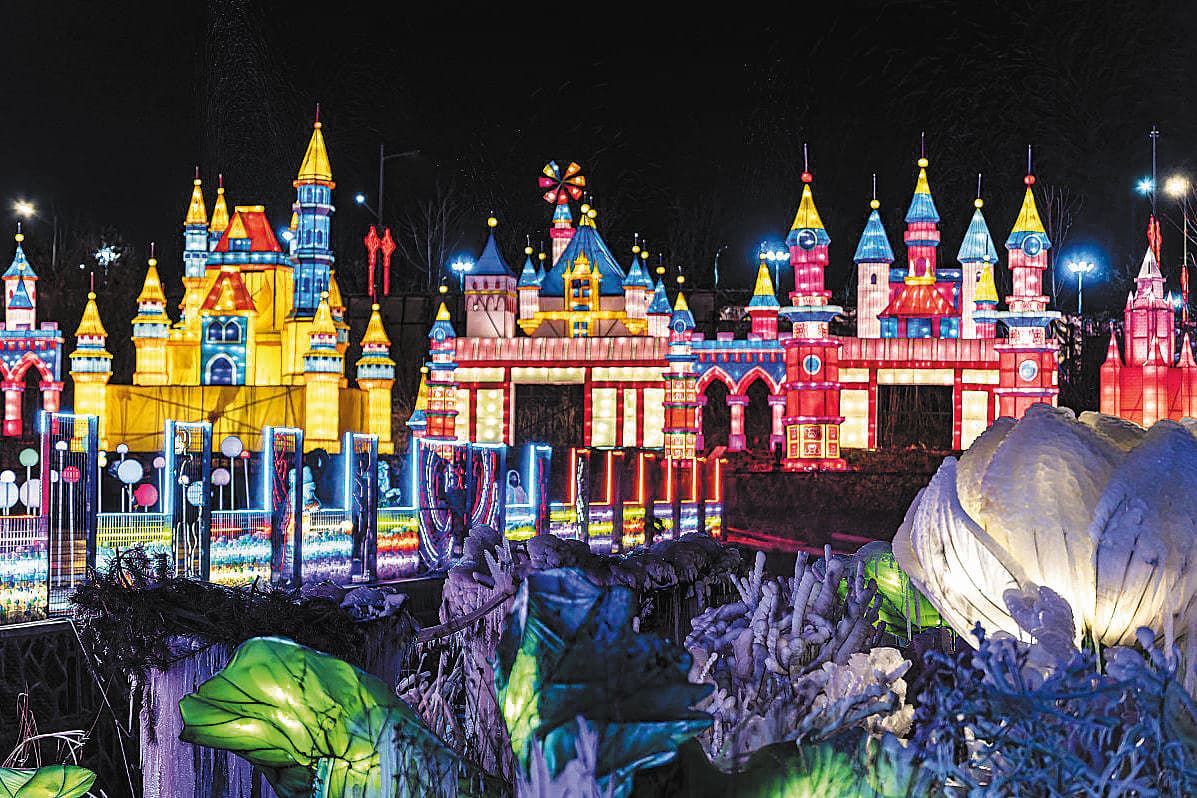
The world's earliest large-scale outdoor ice lantern art exhibition — Harbin Ice Lantern Art Park
Since its inception in 1963, the Harbin Ice Lantern Art Park has become the world's longest-running large-scale outdoor ice lantern exhibition. It is also recognized as the birthplace of China's ice lantern art form. Held at Zhaolin Park, the exhibition has welcomed 30 million visitors over its 50 editions.
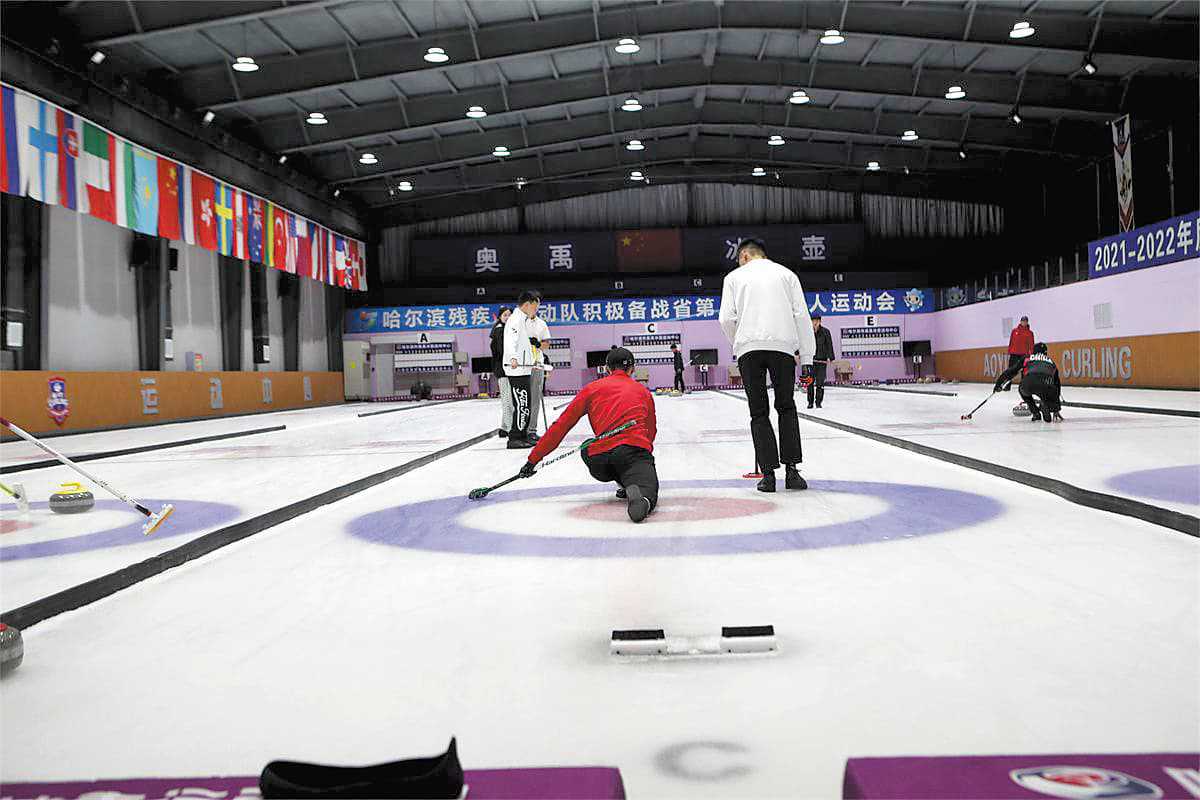
The largest curling sports complex in Northeast China — Harbin Aoyu Curling Sports Center
Covering 20,000 sq m, the Harbin Aoyu Curling Sports Center includes two curling venues with seven international-standard sheets. It hosts the National University Curling Championship, serves as the training site for the national wheelchair curling team and was also the base for China's women's curling team that won gold at the 31st Winter Universiade.
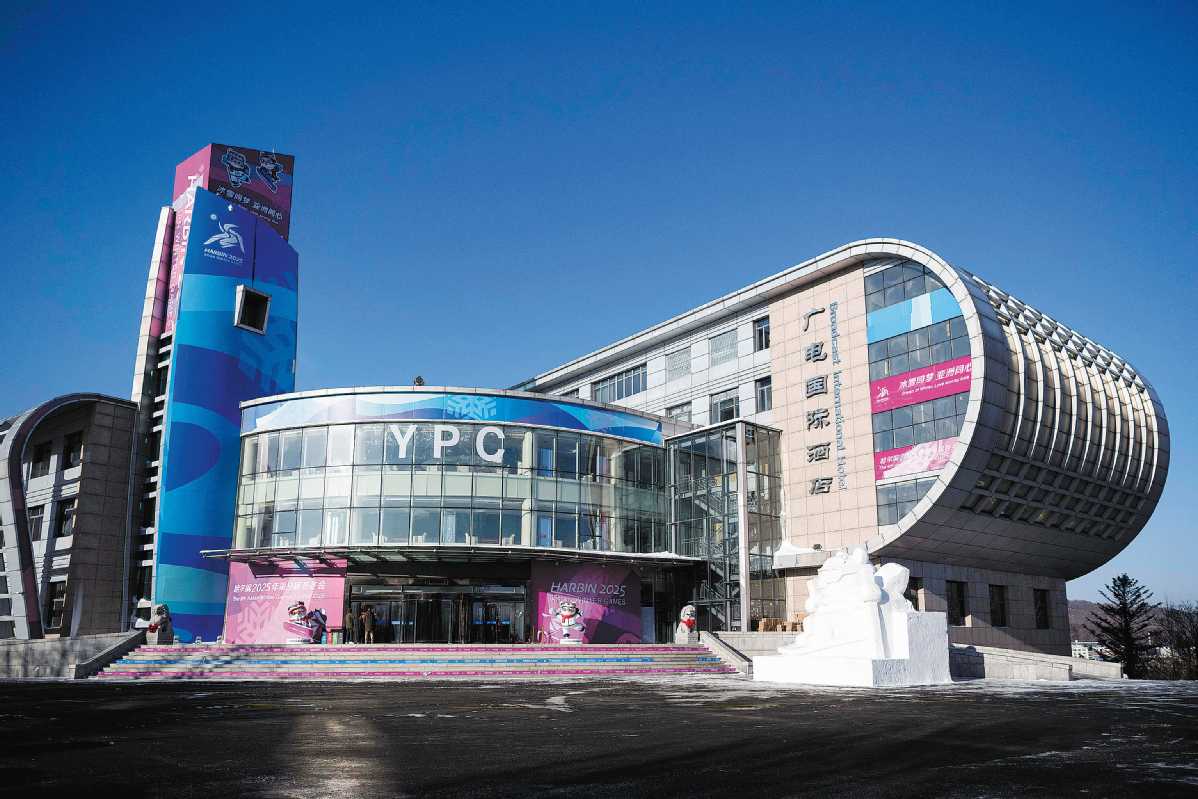
To stick to the green principle of the 9th Asian Winter Games, all 13 venues in Harbin, Heilongjiang province, will use energy-saving, environmentally friendly materials and green, low-carbon technology.
Liu Qinghui, head of the environmental protection team of the athlete services department of the organizing committee, said the team has been intensively preparing a plan for low-carbon hosting since 2023.
"Green energy will be used for the venues' heating, and ultra-low energy consumption technology will be employed for electricity supply, in order to achieve environmental protection goals," Liu said.
According to the organizer, all venues and competitions of the Games will be powered by green electricity, produced from renewable sources with lower environmental impact.
Meanwhile, all construction materials used to upgrade the Harbin Ice Hockey Stadium, which previously hosted the 3rd Asian Winter Games in 1996, are environmentally friendly, said Qin Xulin, director of the Engineering Department of Harbin Urban Development Investment Group.
"All paints and decoration materials used needed to meet strict environmental protection standards," he said.
"Also, the sports lighting fixtures and equipment are all energy-efficient, low-consumption devices."
He added that the construction team has also minimized the use of adhesive agents when building temporary facilities, and that regular tests on air quality in the venue have also been carried out during the construction process.
The Harbin International Conference, Exhibition and Sports Center, venue for the opening and closing ceremonies, has embodied green concepts since its design phase.

Liu Danyang, a designer from Harbin Institute of Technology's Architecture Design Research Institute, said the steel structure of the grandstand in the center would adopt prefabricated construction techniques, reducing on-site pollution from welding materials, shortening construction periods, protecting the environment and more effectively utilizing resources.
What's more, all the venues are based on existing infrastructure that has been renovated, rather than adopting large-scale construction, Wang Hesheng, vice-president and secretary-general of the 9th Asian Winter Games Harbin 2025 Organizing Committee and mayor of Harbin, said.
"In terms of venue construction, there will be no large-scale demolition. Instead, existing venues and facilities have been renovated and upgraded in aspects such as cold air and heat supply, dehumidification, lighting and internet access to meet the needs of the events," Wang said.
He added that, regarding the snow events, which will be held in Yabuli, about 200 kilometers from Harbin, the organizer has made necessary upgrades to existing ski courses, and only revamped and expanded two specialist venues — those for the big air and slopestyle events.
Existing equipment and facilities at the venues can be fully utilized, and the current ice resurfacers, snowmobiles, protective nets, medical rescue facilities and other equipment in Yabuli will all be put into use, Wang said.
Contact the writer at [email protected]

As the 9th Asian Winter Games get underway in Harbin, Heilongjiang province, the spotlight will not only shine on the athletes, but also on the groundbreaking technologies that are set to power the event.
From state-of-the-art digital tools to energy-efficient 5G cameras and pollution-blocking sprays, cutting-edge innovations will ensure a smooth and smart Games experience.
The Asian Winter Games command center, housed in the Asian Winter Games tower, acts as the operational heart of the event, providing a real-time overview of all systems. Central to these operations is China Unicom's specialized cloud platform, designed specifically for international winter events.
Wang Chuanbao, director of China Unicom's Asian Winter Games office, revealed that Heilongjiang Unicom is responsible for the communication infrastructure and service support at all competition and non-competition venues. With network construction now complete, China Unicom will provide 12 key communication services across two major categories throughout the Games, he said.
"We are harnessing the latest technological innovations to ensure the Games run seamlessly, enhancing the experience for athletes and audiences alike," said Wang. "Our aim is to deliver a dynamic, smart, and unforgettable event."
At this year's Asian Winter Games, more than a dozen groundbreaking 5G technologies will be fully utilized, including 5G-A high-precision positioning and 5G-integrated sensing technologies, marking a new era of technological integration in sports.
The Harbin Ice Hockey Stadium, one of the Games' central competition venues, is outfitted with an intricate array of 5G-A antennas suspended above the spectator stands. The 5G-A high-precision positioning will play a crucial role in managing venue operations.
This technology allows event staff to track the real-time locations of individuals, optimizing logistical coordination and boosting operational efficiency to ensure the smooth execution of the Games.
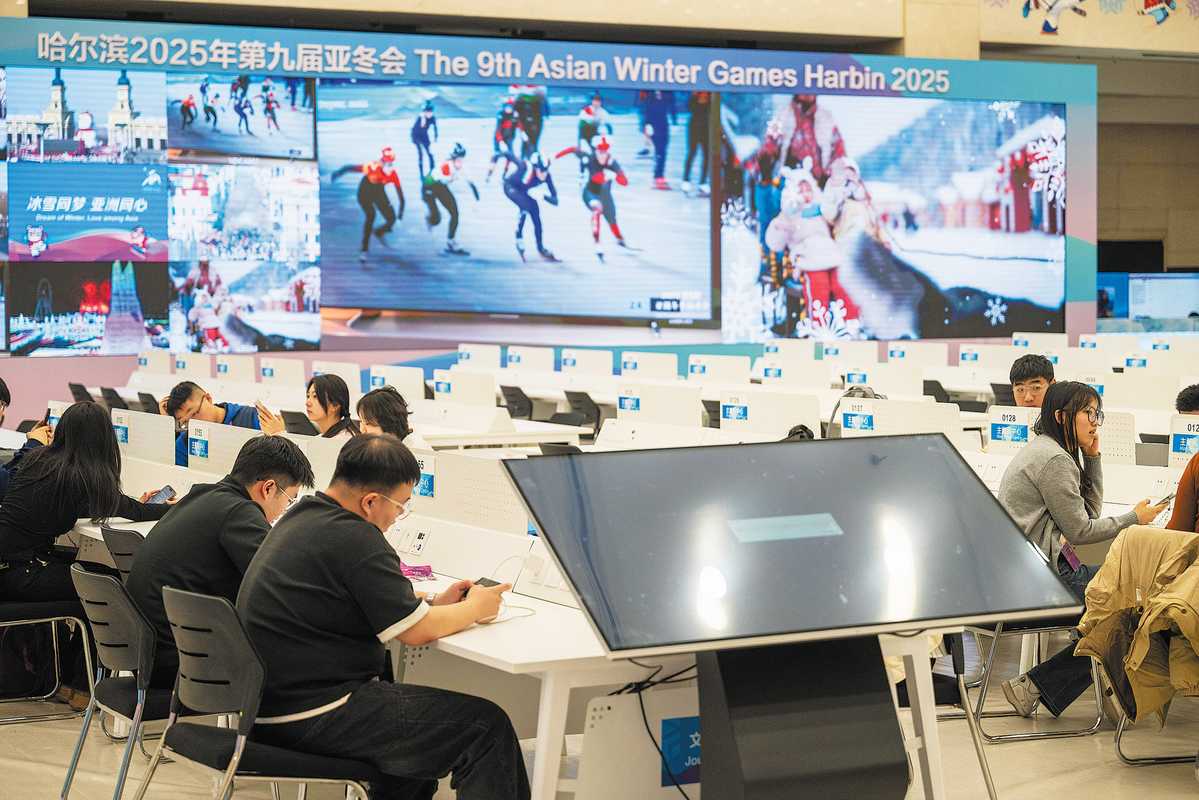
But, the technology doesn't stop there. The arena is also equipped with a dual 10G network, enabling near-instantaneous transfer of critical data — from media live streams and competition footage, to essential work documents — ensuring the stable and seamless operation of every aspect of the event.
At the Yabuli competition areas, a 400G all-optical network provides a stunning 20 percent increase in performance over industry standards.
This ultra-wide-band network creates a high-speed, direct connection between the Yabuli command center and Harbin's main IT operations hub, enabling ultrahigh-definition, real-time monitoring of the ski slopes and the flawless transmission of competition footage.
It also supports sophisticated event scheduling systems, providing a level of seamless integration that makes remote management feel as intuitive as on-site operations.
Further elevating the technological landscape, the Yabuli ski resort, too, is equipped with the latest 5G-A network, which supports integrated sensing applications for low-altitude security and economic activities.
The technology not only mitigates the risk of drone interference, but, post-Games, will also offer convenient services such as low-altitude drone deliveries.
Throughout the venues and server rooms of the Asian Winter Games, it is easy to spot the "sharp-eyed" 5G-RedCap cameras.
These cameras, one of the many 5G innovations powering the Games, are provided by China Unicom's Heilongjiang branch.
Unlike traditional surveillance cameras, the 5G-RedCap cameras are smaller, more energy-efficient, and offer greater flexibility in deployment, explained Ji Yanqi, head of the Smart 5G innovation center at the Heilongjiang branch of China Unicom's technology innovation department.
In addition to the cameras, China Unicom has introduced a 5G-powered communication resource storage management platform, using 5G-A passive IoT technology. This platform enables smart management and real-time tracking of essential event materials.
Equipped with intelligent recognition and precise location tracking, the platform streamlines inventory by enabling quick identification, accurate counting and efficient recovery of lost items.
"With this system in place, manual inventory checks are a thing of the past," Ji said.
The 9th Asian Winter Games have taken a considered, "site-specific" approach to venue upgrades, opting against large-scale demolitions and reconstructions. Instead, technology has been harnessed to ensure the safety and functionality of the transformed spaces, with one notable innovation being the use of a pollution-control spray.
Developed by a team at Harbin Engineering University, the spray is applied using high-pressure, forming a protective layer, up to 30 microns thick, on numerous surfaces.
This layer locks pollutants in place, preventing their release into the air. "The spray effectively traps harmful particles, ensuring a cleaner environment," explained He Zheng, head of the thermo-fluid mechanics and safety technology research team at the university.
The spray is based on advanced polymer surface coating technology, which combines polymer nanomaterials and organic polymers to create a dense, mesh-like film. This film not only prevents the emission of pollutants, but also significantly reduces their harmful effects.
"The spray doesn't just block pollutants; it also provides long-lasting disinfection for up to three months, with a bactericidal and fungicidal efficacy exceeding 99.99 percent. Extensive tests confirm that it is non-toxic, harmless and non-irritating," said Gu Delin, an environmental expert involved with the Games' venue construction team.
Efficient, cost-effective, and easy to apply, the spray is suitable for a variety of settings, including laboratories, hotels and conference halls. Several hotels hosting guests for the Games have already adopted the technology, with positive results. "Our team will continue to provide technical support throughout the Games," Gu added.
Contact the writer at [email protected]
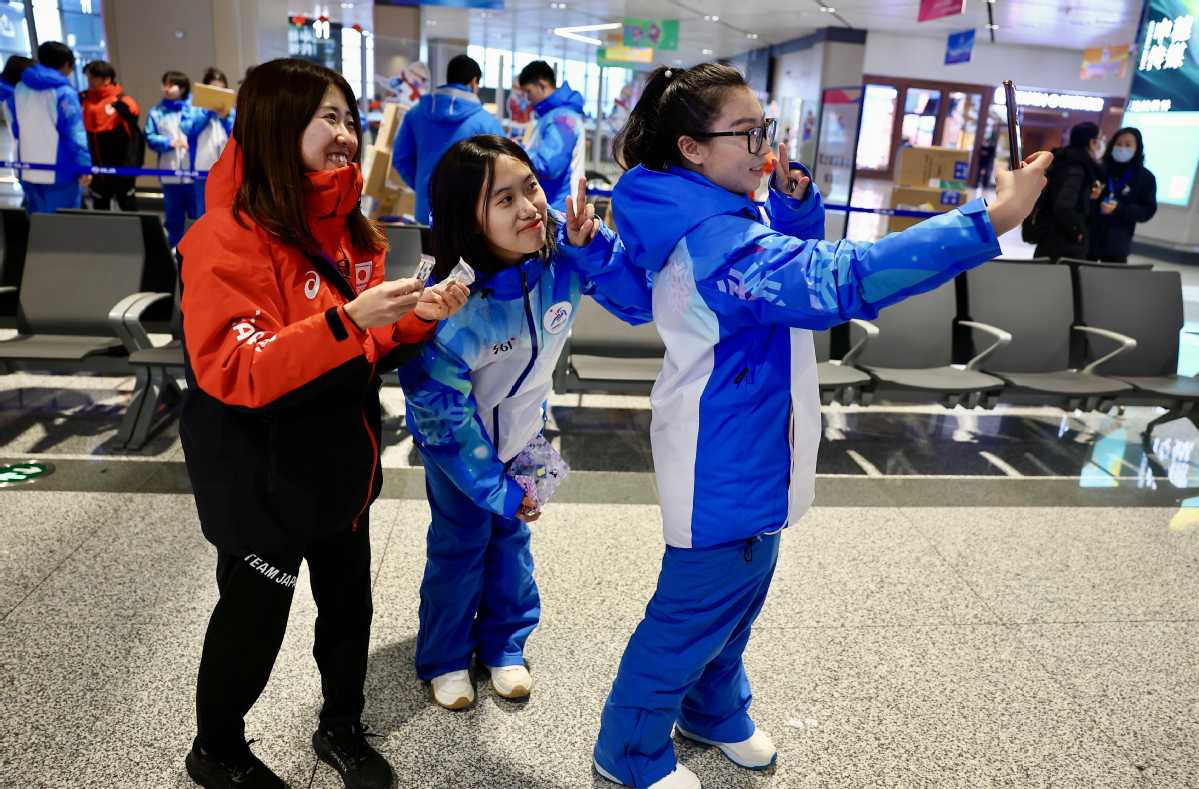
As the Asian Winter Games are set to get underway in Harbin, capital of Heilongjiang province, both the city and event organizers are ready to welcome athletes, officials and spectators from around the globe. Among them, an army of volunteers stands poised to provide professional and enthusiastic services, aiming to create lasting memories with their warm smiles and meticulous support.
The Games recruited an international cohort of volunteers, receiving more than 100,000 applications. After a rigorous selection process, including interviews and screenings, 6,000 volunteers were selected.
The volunteers hail from across China, with a strong representation from universities in Heilongjiang, as well as over 400 international students, representing 22 countries and regions.
Around a quarter of the volunteers have previous experience, having served at major events, such as the Hangzhou Asian Games, Beijing Winter Olympics and last summer's Paris Olympics.
Nearly 500 of the volunteers are skilled in skiing, and others bring expertise from 35 specialized areas, including medical support, information services and media relations.
Han Cong and Sui Wenjing, the 2022 Beijing Winter Olympics pairs figure skating champions and Harbin natives, have been appointed as the ambassadors for the volunteer service at the 9th Asian Winter Games.
"We are incredibly proud to be named ambassadors of the Games in our hometown," said Sui. "It's an honor, and we're committed to doing everything we can to bring attention and pride to Harbin, ensuring it continues to shine on the world stage."
For this year's Games, a practical approach was taken in preparing volunteers, who participated in 50 specialized courses covering areas such as competition services and award ceremony etiquette. In total, more than 100 training sessions have been held, spanning general knowledge, professional skills and job-specific preparation.
During the recently concluded test events, volunteers not only provided expert and thoughtful service, but also honed their real-world skills. Their efforts reflect the vibrant energy of China's youth, earning praise from the Olympic Council of Asia, international delegations and various other sectors.
City volunteers began their work well before the start of the Games, with their busy presence seen throughout Harbin's scenic spots, shopping districts, subway stations and other key areas.
More than 20,000 city volunteers are stationed throughout key areas. Their responsibilities include traffic guidance, site introductions and general assistance, all aimed at ensuring a smooth and welcoming experience for visitors.
Volunteers are easily identifiable in their Asian Winter Games-themed vests, with many stationed at iconic landmarks like Central Street and St. Sophia Cathedral.
Whether directing pedestrians or offering insights about local attractions, the volunteers play a crucial role in enhancing the visitor experience. Some, fluent in foreign languages, provide additional support to international guests, answering questions and offering cultural insights.

Zhang Limei, a city volunteer, explained: "More than 220 volunteers rotate shifts here, with three shifts a day. We provide visitors with the information they need, such as directions, tourist spots, and bus schedules."
Shi Xiaojin, another volunteer, shared that the experience has also been a personal growth opportunity. "My language skills have greatly improved through communication with foreign visitors. We exchanged cultural experiences, and many expressed high praise for Harbin."
Wang Siyu, a textile engineering major at Qiqihar University, heads the volunteer service station at Harbin West Railway Station. With over 200 hours of service under her belt, she is known for being the first to arrive and the last to leave each day.
Wang ensures the station is well-stocked with supplies, including cold-weather gear and promotional materials. She also mentors new volunteers, guiding them through their tasks and offering advice based on her extensive experience.
In a bid to enhance convenience and warmth for athletes, visitors and locals during the Asian Winter Games, Harbin has set up 56 volunteer service kiosks across the city.
Located near major sports venues, these service points extend into bustling commercial districts and tourist attractions. Strategically placed in high-traffic areas, such as competition and non-competition venues, popular shopping areas, scenic spots and transportation hubs, the kiosks are positioned to assist visitors throughout the Games.
According to an official from Harbin's urban management bureau, the service kiosks are not only designed as hubs for volunteers to offer their assistance, but also to provide a variety of services, including information consultation, emergency aid and civil guidance.
Whether it's helping tourists navigate the city's attractions, or offering quick responses to people in need, the kiosks ensure immediate support. Additionally, they offer a comfortable resting place for the volunteers working tirelessly throughout the event, the official said.
Contact the writer at [email protected]

Since its official operation on Jan 31, the newly renovated and upgraded Huaqi Hotel in Harbin, Heilongjiang province, has welcomed around 900 athletes and officials for the 9th Asian Winter Games, which are set to begin on Friday night.
The hotel, located in the same complex as the Main Media Center and the venues for the opening and closing ceremonies, serves as the Athletes' Village for those contesting the ice sports competitions in the city's downtown area.
Built in 2005, the hotel has 41 floors and 625 rooms.
In preparation for the Games, it underwent a comprehensive renovation, including the replacement of the elevators.
The restaurant is adorned with decorations and murals themed around the Games, as well as the beautiful winter scenery of Heilongjiang.
In the athletes' rooms, welcome cards, mascot cutouts and traditional folk art pieces were prepared ahead of their arrival.
"The standard rooms are equipped with two beds measuring 1.2 meters by 2 meters," said Chen Jin, director of the guest room department. "We have also prepared bed extensions to accommodate the height of some of the taller athletes."
During the Spring Festival period, the rooms and public areas were decorated with Chinese New Year motifs like the Chinese character "fu", which symbolizes good fortune, to create a festive atmosphere.
To meet the diverse dietary needs of athletes from across Asia, Wang Gang, the hotel's executive chef, along with his colleagues, has prepared over 100 dishes, offering a variety of flavors to cater to different culinary requirements.
"We have nutrition-rich Western dishes on the menu, such as steak and pasta," said Wang. "There are also unique flavors from Southeast Asia and delicious Chinese dishes, including local specialties such as guobaorou (sweet-and-sour pork or beef), chicken stewed with mushrooms, and Harbin sausages, all tailored to meet the nutritional needs of athletes during high-intensity competition or training."
In the restaurant, a visual management system displays information such as water usage in the kitchen and dish retention.
"The system can show whether there are flies in the kitchen, monitor kitchen staff, and other conditions, primarily ensuring the dining safety of athletes," said Wang. "Additionally, the system can provide information on dish retention, energy management and risk event statistics."
During the Games, a clinic in the Athletes' Village will also provide medical support for competitors.
With departments including internal medicine, a surgery and a pharmacy, the clinic has multiple rooms tailored to the needs of athletes and is equipped with electrocardiograms and ultrasound machines.
"There are dozens of medical staff members from the hospitals affiliated with Harbin Medical University and Heilongjiang University of Chinese Medicine," said Pan Yu, manager of the clinic. "Many doctors on the team have studied abroad, so they can integrate international methods and advanced medical concepts into daily diagnosis and treatment, providing athletes with cutting-edge medical services."
Considering that athletes urgently need relaxation and recovery after high-intensity competition, the clinic has added traditional Chinese medicine procedures, such as acupuncture, massage and other traditional therapies, to help athletes relieve fatigue and quickly recover from the rigors of competition.
As one would expect, the Athletes' Village also has a fully equipped gym, and even a licensed merchandise retail store.
Serene surroundings
Meanwhile, the snow sports athletes are also well catered for at their accommodation in Yabuli.
The serene surroundings of the Avaunce Hotel provide an ideal place for the athletes to rest and prepare for their competitions.
The exterior decoration of the hotel adopts a modern minimalist style that harmonizes with its natural surroundings.
The Games' mascots Binbin and Nini, a pair of cute Siberian tigers, have been placed on either side of the hotel's main entrance to welcome guests.
With a celebratory atmosphere created by the Games, and decor to match, the lobby features a spacious lounge area, providing a comfortable environment for athletes and coaches to relax and hang out.
To ensure that athletes can dine promptly after competition, a storage area for skis and other large snow sports equipment is located next to the restaurant.
The restaurant has been divided into multiple areas to meet the dining needs of athletes from different countries and regions.
Additionally, the restaurant emphasizes nutritional balance to ensure that athletes receive sufficient energy support during competition.
There are meeting rooms, clinics, office areas and a language service center to provide athletes with one-stop assistance during their stay.
The hotel has over 230 standard rooms, along with double rooms and triple rooms, to meet the accommodation needs of over 500 people.
"All staff at our hotel will provide Asian Winter Games athletes with a warm and comfortable home full enthusiasm and professional service," said Liu Guangpeng, deputy general manager of the Yabuli Tourism Investment Group. "We will spare no effort to ensure that every athlete can enjoy the best rest and preparation during the Games."
Contact the writer at [email protected]
TIAN XUEFEI and ZHOU HUIYING in Harbin
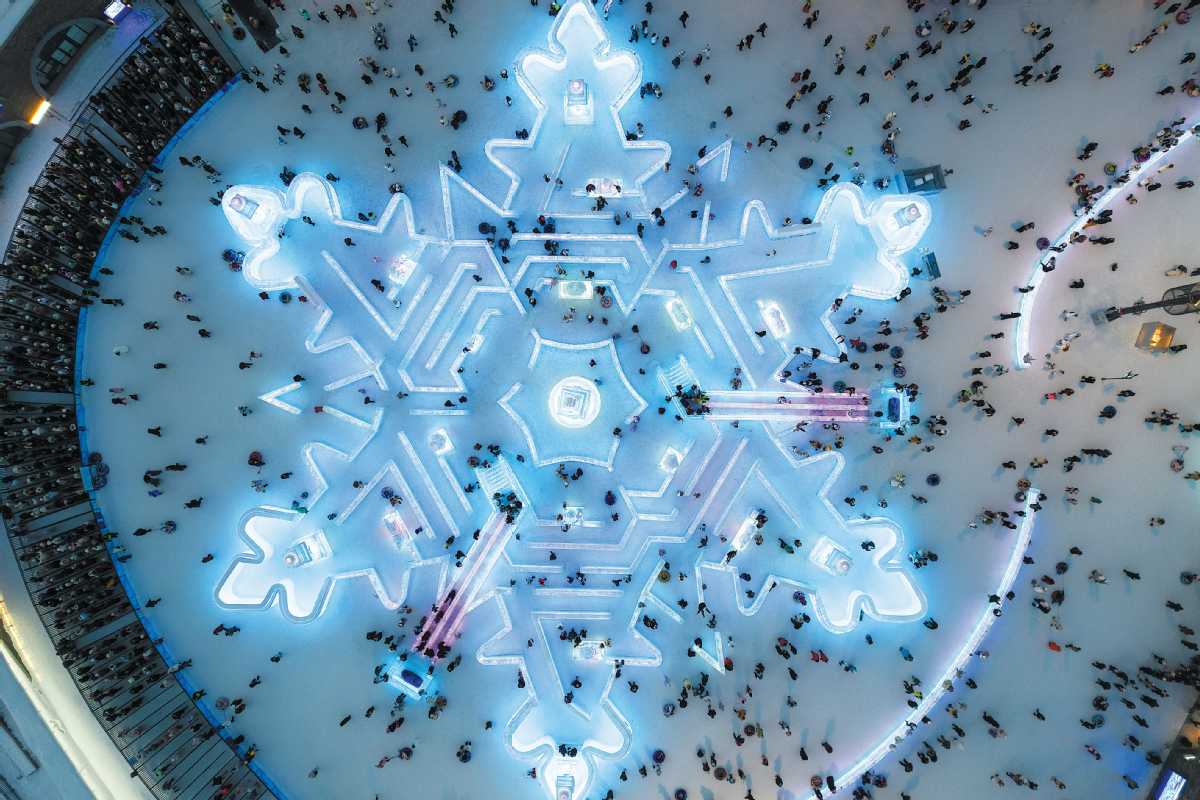
With the combination of Chinese culture and local Heilongjiang flavor presented in a thrilling high-tech way, the opening ceremony of the Harbin Asian Winter Games promises to dazzle with a cool celebration of sporting feats and continental unity.
The ceremony, which starts on Friday night at the Harbin International Conference, Exhibition and Sports Center, will deliver a captivating glimpse of the host city's unique winter charm with Harbin's landmarks, local cultural elements and its winter sports tradition demonstrated in the show, according to the ceremony's creative team.
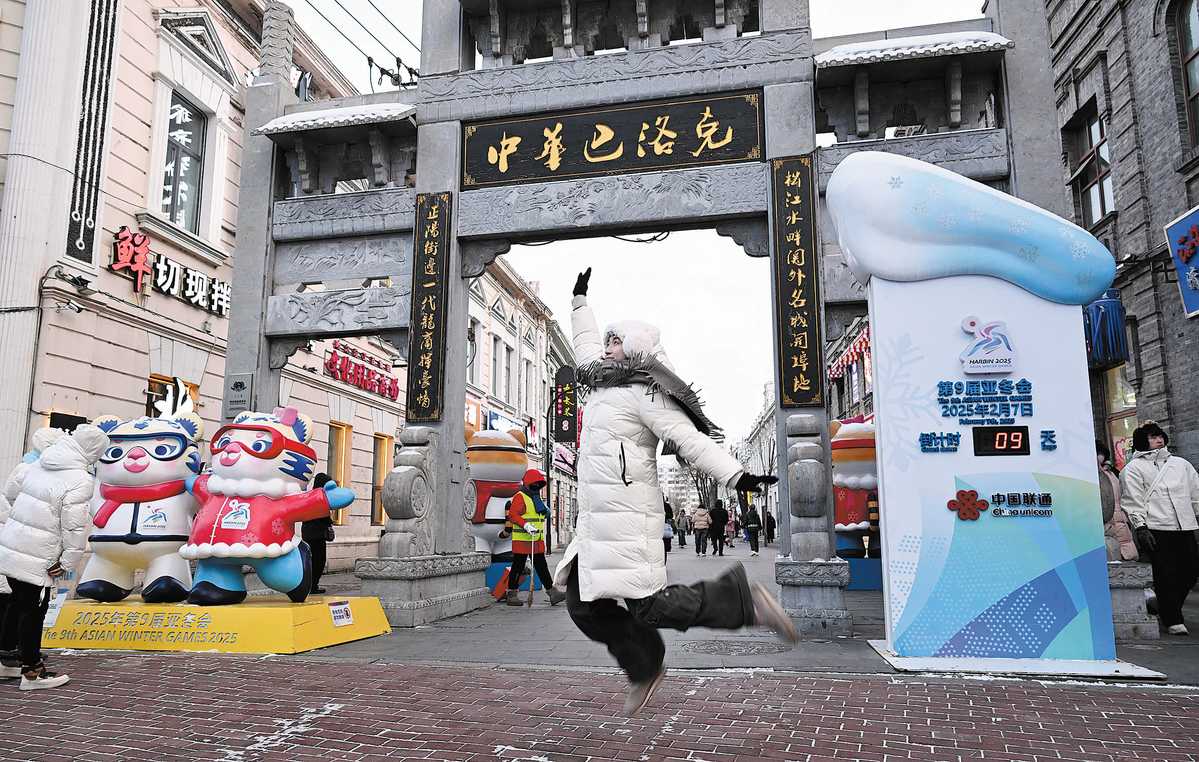
The breathtaking beauty of the "Ice City", as Harbin is known throughout the world, set the tone for the aesthetic and programming of the entire show, which is sure to leave a profound impression on every spectator, said Sha Xiaolan, chief director of the opening and closing ceremonies of the Games.
"A series of local cultural elements, folk activities and the city's natural bond with ice and snow, which impressed our crew, will be integrated into the ceremony in a creative way," said Sha, who was also the mastermind behind the highly acclaimed ceremonies for the 2023 summer edition of the Games in Hangzhou.

"In addition to demonstrating Harbin's profound tradition and history, we'd like to promote more of the vibrant image of modern China and the aspiring spirit of Chinese people," Sha added.
The Games' official slogan "Dream of Winter, Love among Asia" was also adopted as the inspiration for the theme of the opening show, while the creative team's yearlong preparatory work of research, field study and interviews has added so much more to enrich the ceremony's artistic and cultural flair, according to chief producer Wu Yan.
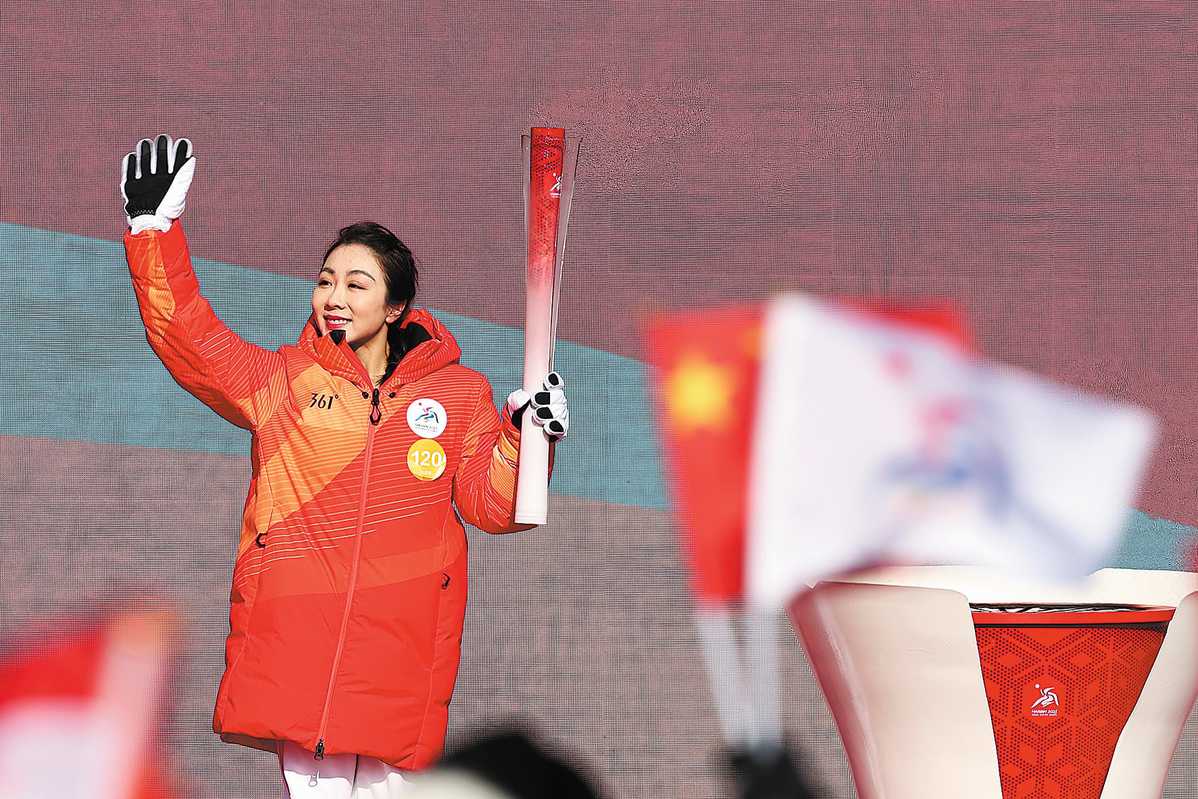
"We've done over 40 revised versions of the programming, and have done all we can to perfect each and every detail," said Wu, who was on Sha's team for the Hangzhou Games in 2023.
To highlight the thrilling winter attraction of Harbin, the opening ceremony — with the majority of its program staged at the indoor exhibition center — will also feature outdoor performances at the Harbin Ice and Snow World, a must-visit tourism destination featuring astonishing ice sculptures, where rehearsals have been carried out since November.
The stage effects at the exhibition center will be significantly enhanced by digital technologies, such as augmented reality, glasses-free 3D animations and ultra HD background screens, to guarantee an immersive experience for both live spectators and television viewers, said Wu.
Use of such high-tech techniques will help the creative team put Harbin's "coldest and prettiest" beauty of ice and snow on display, together with the "hottest and warmest "emotions of the host, as it calls for solidarity throughout Asia, according to Leng Song, chief writer for the ceremonies.
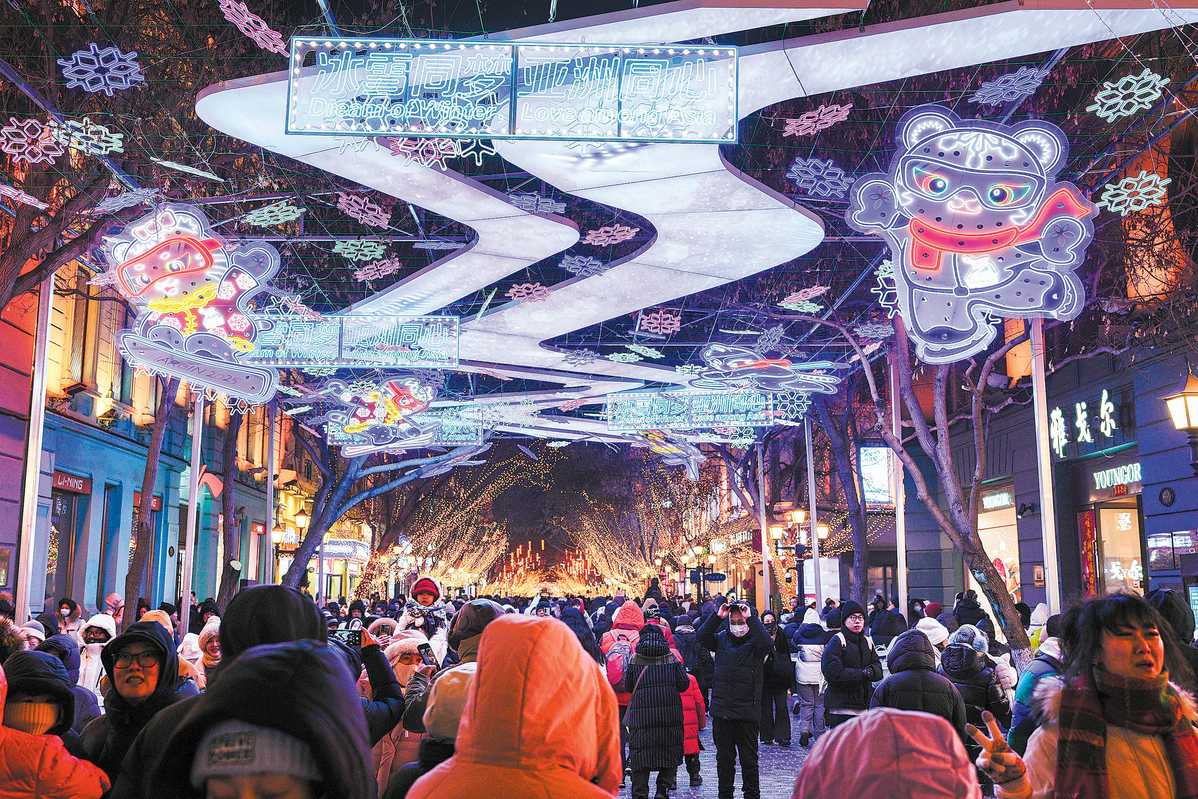
"The entire opening ceremony venue will be built into an innovative 'reception room' for guests across Asia," said Leng.
"We are striving to extend our imagination and the host's generosity beyond the limit of the performing space," he said.
Nearly 1,000 performers involved in the opening ceremony — who are mainly local college students — have been training and rehearsing for the show for over two months, according to producer Wu.
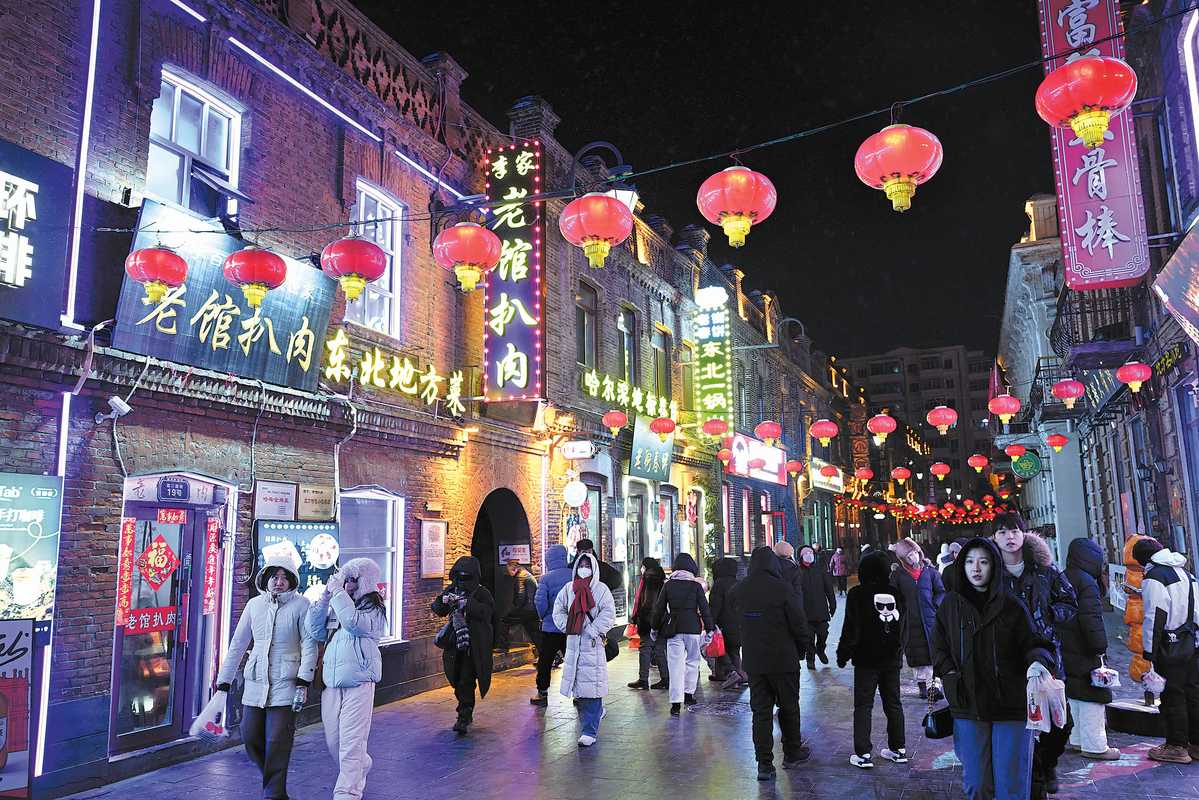
Despite Harbin's sometimes extreme cold, the passion and dedication of everyone on the cast have inspired them to keep pursuing perfection in their performances.
"The freezing cold is intimidating, but the passion of everyone involved has been so uplifting that we've all been bursting with extra enthusiasm," said Wu.
"We are fully confident that we will put on a unique and impressive opening show for everyone across Asia to remember."

HARBIN -- Ning Zhongyan and Liu Mengting have been named as the Chinese delegation's flagbearers for the opening ceremony of the 2025 Harbin Asian Winter Games.
Ning, 25, is a star speed skater who has won multiple ISU World Cup medals since 2019.
Liu, 20, made history in January by claiming her first FIS Freeski World Cup victory in the women's big air event in Klagenfurt, Austria.
The opening ceremony of the Harbin Asian Winter Games is scheduled to take place on Friday.
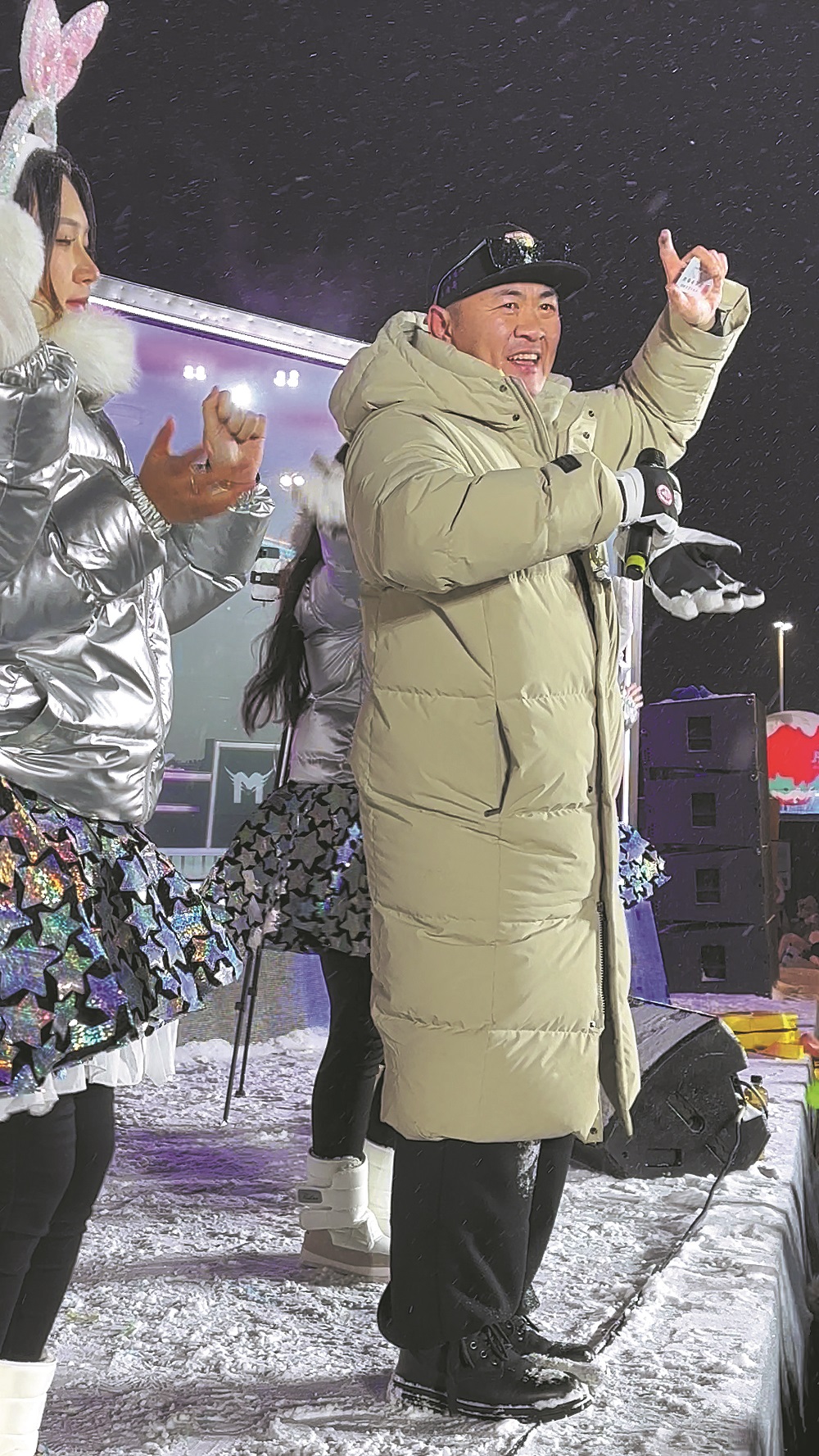
When night falls, the Harbin Ice and Snow World, a snow and ice wonderland, turns into a thrilling nightclub, with tens of thousands of people dancing along with Jiang Kedong, a local who knows how to get everyone rocking.
Dubbed "Brother Left and Right", the 39-year-old has witnessed how his hometown's fame has grown, and he became a bit of a celebrity as a performance host at last year's Harbin Ice and Snow World, a landmark theme park in the capital of Northeast China's Heilongjiang province.
"It is my hometown that people come for, not me," Jiang said.
He added that Harbin is a fascinating city that's worth visiting.
Jiang became an auto production worker in 2006, but supplemented his income with several part-time jobs, including one as the drummer for a wedding band.
As music technology resulted in digital music replacing live bands at weddings, Jiang's drumming career fizzled out, but the experience saw him forge lasting connections within the wedding industry.
In 2011, he resigned from the auto factory to become a wedding host. It was at a wedding that he met the person in charge of performances at the Harbin Ice and Snow World, who invited him to visit the winter extravaganza.
This chance meeting marked the beginning of Jiang's association with the theme park, which grew from the Harbin Ice Lantern Festival, which started in 1963.
"My first impression of the park 12 years ago was 'wow! It's so big!'
"In the following years, I saw it become even bigger."
When there were too many visitors, fearing that they would fall, or cause a stampede, during the interactive session he would shout: "Left foot, right foot!" This earned him his odd nickname.
Over the years, Jiang has enjoyed growing success. On short-video platform Douyin, the number of people following him soared from hundreds to 3.61 million.
"Living in the ice city, I'm just like a snowflake flying in a world of ice and snow, and I hope to make a greater contribution to my hometown," he said.
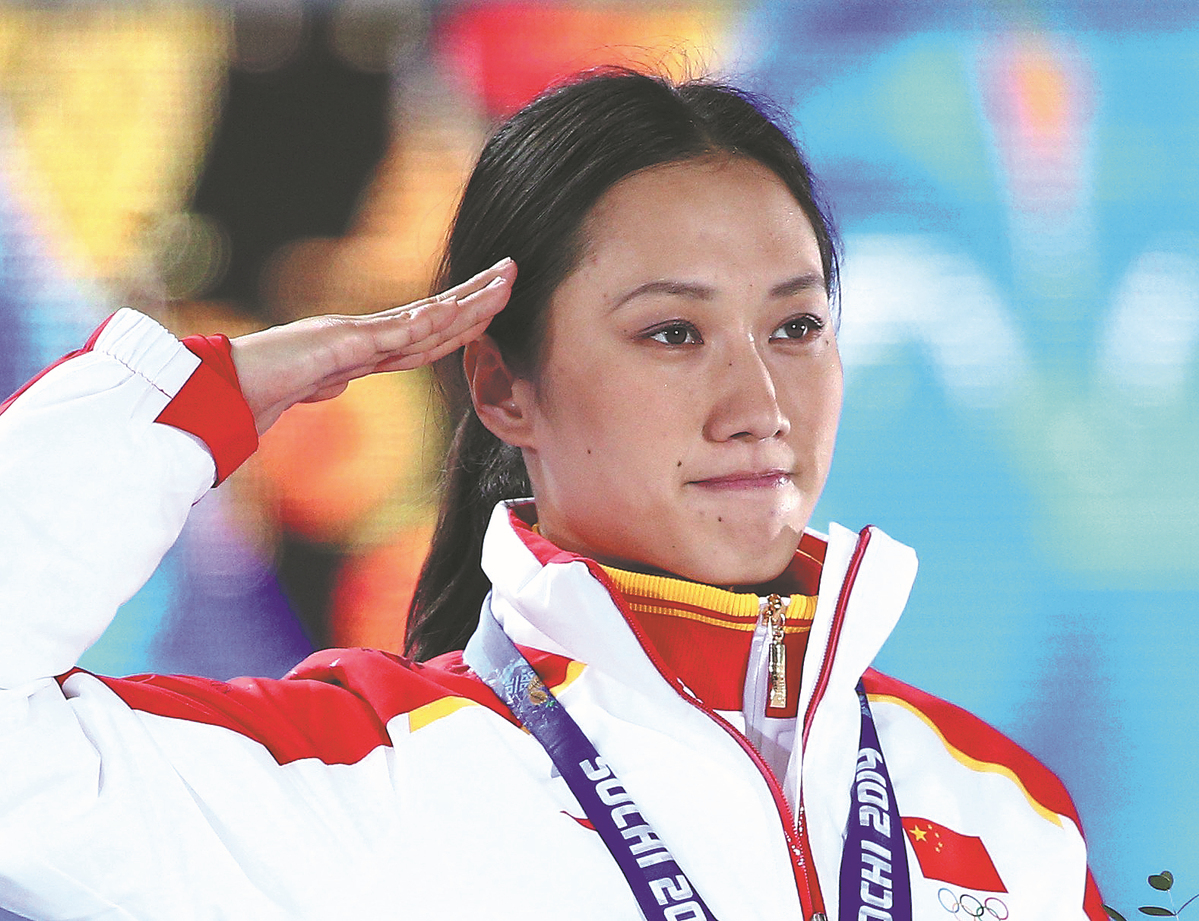
"I was born, and grew up, on this black soil of my hometown. From the start of my speed skating career, to winning the Winter Olympics gold medal, I have always trained on this land. Therefore, I am especially looking forward to Harbin once again hosting the Asian Winter Games."

"They have the knowledge, the wherewithal and the government support. And they have the experience from the Beijing Winter Olympics in 2022 and also the Hangzhou Asian Games, which have brought a lot of expertise in organizing international sporting events in China. So, I'm sure we will see a very high-standard Games here in Harbin."
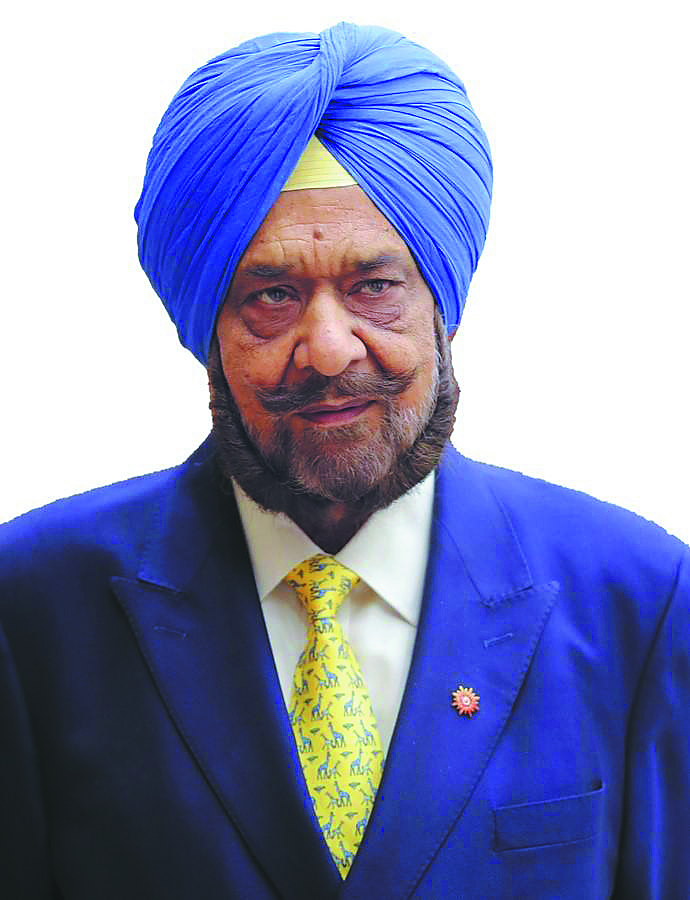
"Harbin will become the second city to have hosted two editions of the Asian Winter Games, which will be a significant honor for the city and a brilliant milestone in the history of the Asian Winter Games. China has rich experience in hosting major sports events, and Harbin has demonstrated professionalism, efficiency, and outstanding work preparing for the Asian Winter Games."

"Heilongjiang province is focusing on integrated cultural, sports, and tourism routes, connecting the venues of the Asian Winter Games with nearby scenic spots, allowing visitors to not only enjoy the exciting competitions, but also to fully experience the charm and unique style of the 'Ice City'."

"I'm very happy that the Asian Winter Games are being held in my hometown, Harbin. I will also participate in the event as the president of the Athletes' Commission of the Olympic Council of Asia. I warmly welcome everyone to come to Heilongjiang and Harbin to experience the charm of this city, including its food, scenery and the warm hospitality of its people."

"The ice rinks in Harbin carry my childhood memories. Every inch of the ice surface has witnessed my growth. It's been 29 years since Harbin first hosted the Asian Winter Games. This year's Games are not only a reunion, but also an important opportunity for Harbin to once again showcase the charm of ice and snow to the world."

"My impression of Harbin is that it has distinct seasons, especially winter, which is the most beautiful. Everywhere you go, there are beautiful ice sculptures. My hometown has produced many outstanding athletes, and I hope that this time at the Asian Winter Games, we will see even more talented athletes rise to the occasion."

"As a professional athlete and coach, I know that every achievement of the athletes is hard-earned. I hope every athlete can break through their limits and achieve excellent results at the Asian Winter Games. I also hope the whole world will see the charm and enthusiasm of Harbin."

"I'm very excited to participate in the Asian Winter Games, especially in my hometown Harbin. I grew up in Yabuli, and being able to return to the ski slopes of my childhood makes me really happy."
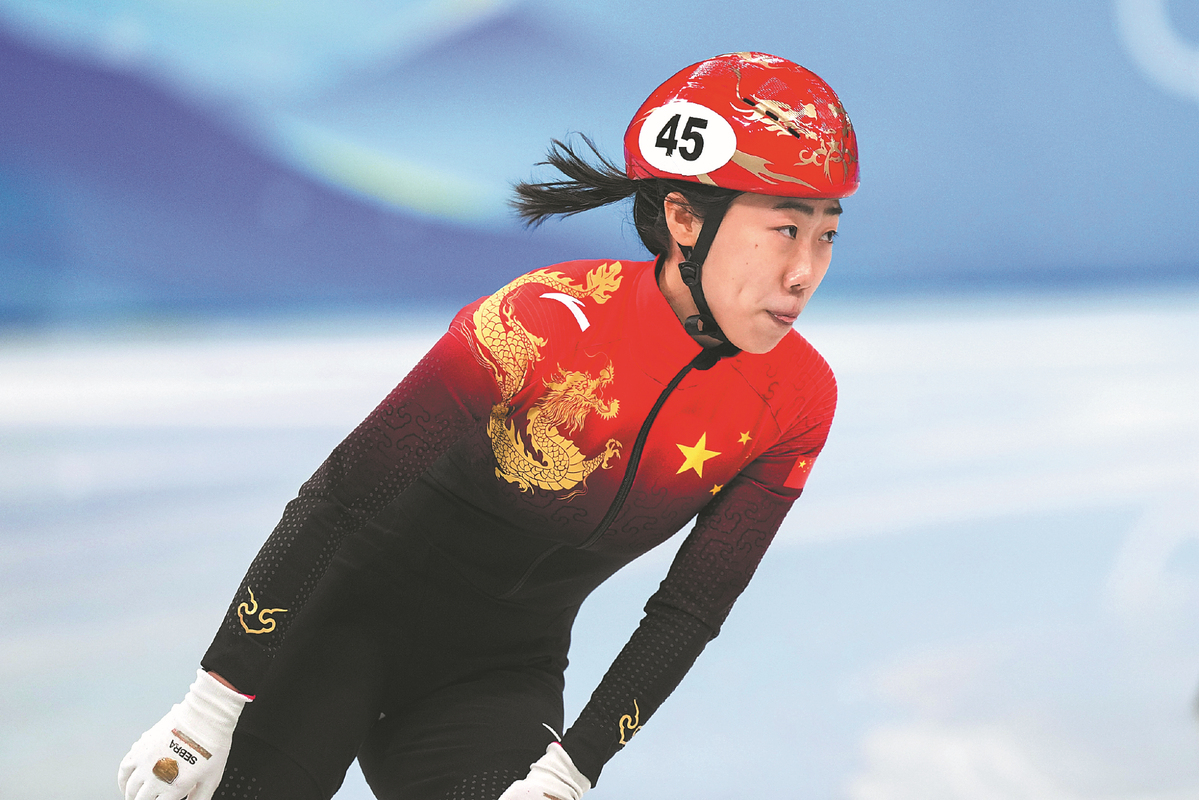
"Harbin, a city filled with deep emotions and memories for me, is like a northern pearl, nestled on the vast banks of the Songhua River. Its unique ice and snow charm, combined with the fusion of Eastern and Western cultures, shines with a special brilliance. Harbin's winter always fills one with anticipation, as the thick white snow transforms the city into a fairy tale world, attracting countless enthusiasts to experience this magical gift from nature."

"As a local, I hope Harbin can present a different image to the entire nation, Asia, and even the world. I also hope that, through the Asian Winter Games, everyone can experience the unique beauty and charm of this northern 'Ice City'."

With a combination of Chinese culture and local Heilongjiang flavor presented in a thrilling high-tech way, the opening ceremony of the Harbin Asian Winter Games promises to dazzle with a cool celebration of sporting feats and continental unity.
The ceremony, which starts on Friday night at the Harbin International Conference, Exhibition and Sports Center, will deliver a captivating glimpse of the host city's unique winter charm with Harbin's landmarks, local cultural elements and its winter sports tradition demonstrated in the show, according to the ceremony's creative team.
The breathtaking beauty of the "Ice City", as Harbin is known throughout the world, set the tone for the aesthetic and programming of the entire show, which is sure to leave a profound impression on every spectator, said Sha Xiaolan, chief director of the opening and closing ceremonies of the Games.

"A series of local cultural elements, folk activities and the city's natural bond with ice and snow, which impressed our crew, will be integrated into the ceremony in a creative way," said Sha, who was also the mastermind behind the highly acclaimed ceremonies for the 2023 summer edition of the Games in Hangzhou.
"In addition to demonstrating the profound tradition and history, we'd like to promote more of the vibrant image of modern China and the aspiring spirit of Chinese people," Sha added.
The Games' official slogan "Dream of Winter, Love among Asia" was also adopted as the inspiration for the theme of the opening show, while the creative team's yearlong preparatory work of research, field study and interviews has added so much more to enrich the ceremony's artistic and cultural flair, according to chief producer Wu Yan.
"We've done over 40 revised versions of the programming, and have done all we can to perfect each and every detail," said Wu, who was on Sha's team for the Hangzhou Games in 2023.
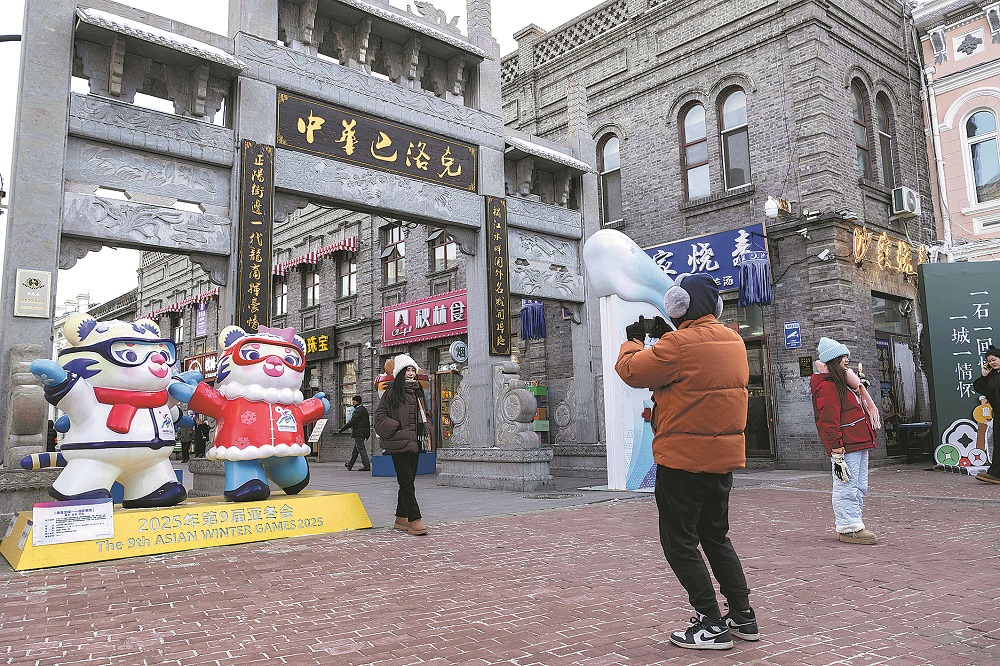
To highlight the thrilling winter attraction of Harbin, the opening ceremony — with the majority of its program staged at the indoor exhibition center — will also feature outdoor performances at the Harbin Ice and Snow World, a must-visit tourism destination featuring astonishing ice sculptures, where rehearsals have been carried out since November.
The stage effects at the exhibition center will be significantly enhanced by digital technologies, such as augmented reality, glasses-free 3D animations and ultra HD background screens, to guarantee an immersive experience for both live spectators and television viewers, said Wu.
The use of such high-tech techniques will help the creative team put Harbin's "coldest and prettiest" beauty of ice and snow on display, together with the "hottest and warmest" emotions of the host as it calls for solidarity throughout Asia, according to Leng Song, chief writer for the ceremonies.

"The entire opening ceremony venue will be built into an innovative 'reception room' for guests across Asia," said Leng.
"We are striving to extend our imagination and the host's generosity beyond the limit of the performing space," he said.
Nearly 1,000 performers involved in the opening ceremony — who are mainly local college students — have been training and rehearsing for the show for over two months, according to producer Wu.
Despite Harbin's sometimes extreme weather — with temperatures dropping to as cold as minus 20 degrees Celsius during outdoor night drills — the passion and dedication of everyone on the cast have inspired them to keep pursuing perfection in their performances.
"The freezing cold is intimidating, but the passion of every performer and staff member involved has been so uplifting that we've all been bursting with extra enthusiasm to overcome the sometimes punishing weather," said Wu.
"We are fully confident that we will put on a unique and impressive opening show for everyone across Asia to remember."
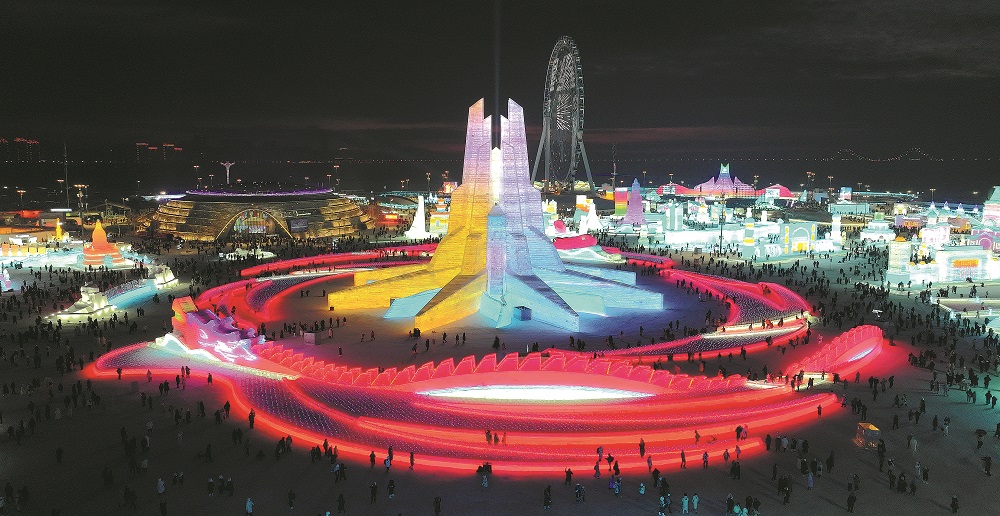
Since its opening on Dec 21, the 26th Harbin Ice and Snow World, in the capital city of Northeast China's Heilongjiang province, has welcomed numerous tourists from home and abroad.
With the theme of "Dream of Winter, Love Among Asia", the world's largest ice-and-snow theme park has been expanded from 810,000 square meters to 1 million this winter.
"The park's design and construction fully integrates elements of the 9th Asian Winter Games, creating a more dazzling ice and snow theme park this winter," said Luo Xin, deputy general manager of Harbin Ice-Snow World Co.
A series of activities, including an ice harvesting festival, a new fantasy show, outdoor performances and ice carving competitions, among other events, have been held during the winter.
Gliding down an ice slide more than 500 meters in length, Zhang Jiajia felt like she was flying, and that her one-minute experience had been worth the hour-plus wait in line.
"It's super exciting, and my heart soared with me," said Zhang, a tourist from East China's Zhejiang province, after completing her descent.

The park boasts the largest scale in its history, with more than 300,000 cubic meters of ice and snow sculpted across nine zones, recreating landmarks and landscapes of the 45 countries and regions, including China's Temple of Heaven, Japan's Osaka Castle and India's Taj Mahal.
The main attraction of the park — a tower called Love Among Asia — draws inspiration from the official emblem of the Olympic Council of Asia.
The tower's core has the shape of a radiant sun, representing the vigorous development of Asia and Asian sports.
The structure is surrounded by a dragon and an eagle, symbolizing East, Central and West Asia, respectively. Their appearance together expresses unity and common development among Asian countries. The tower's main structure is composed of staggered ice columns, creating the visual effect of ascending levels. Designers also incorporated the latest lighting technology, using a full-color variable lighting linkage control system.
Via preset programs and wireless cloud platform control of its color and display modes, it makes for a stunning visual feast.
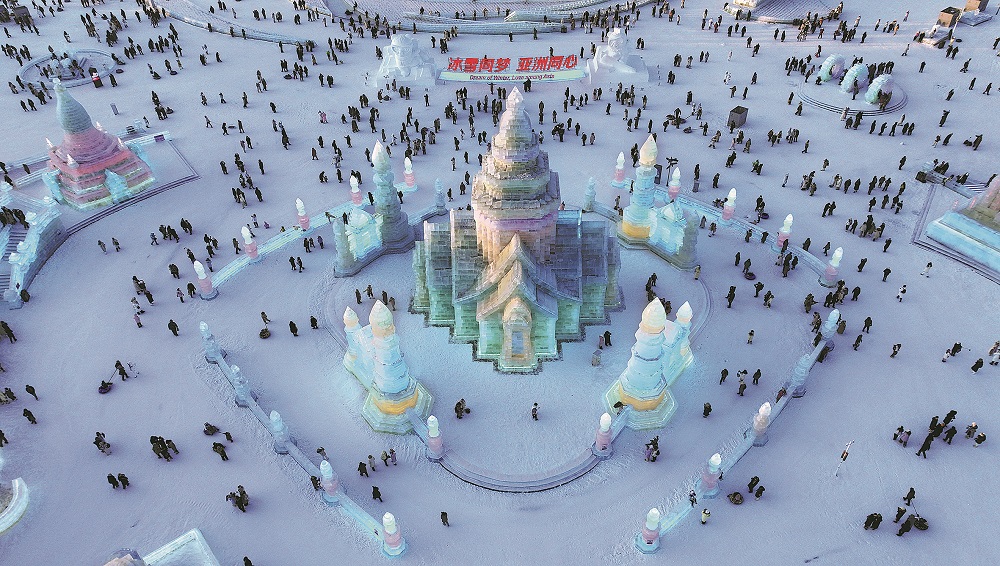
There is also a supersized maze in the shape of a snowflake in the park this year, providing visitors with a brand-new experience, according to the organizers. As night falls, the ice walls will be illuminated.
The paths inside the ice maze are meticulously calculated and carefully planned. They feature interactive scenes inspired by the 12 animals of the Chinese Zodiac, which were designed by renowned artist Han Meilin. There are also more than 20 carefully designed small ice slides scattered throughout the park, each with a beautiful and whimsical appearance.
The park has strategically located commercial services and multiple high-end boutique restrooms to meet the practical needs of visitors during their tour.
All four-season ice and snow projects are fully operational, with additional warm shelters added throughout the park for visitors to take a break and warm up whenever they feel cold or tired.
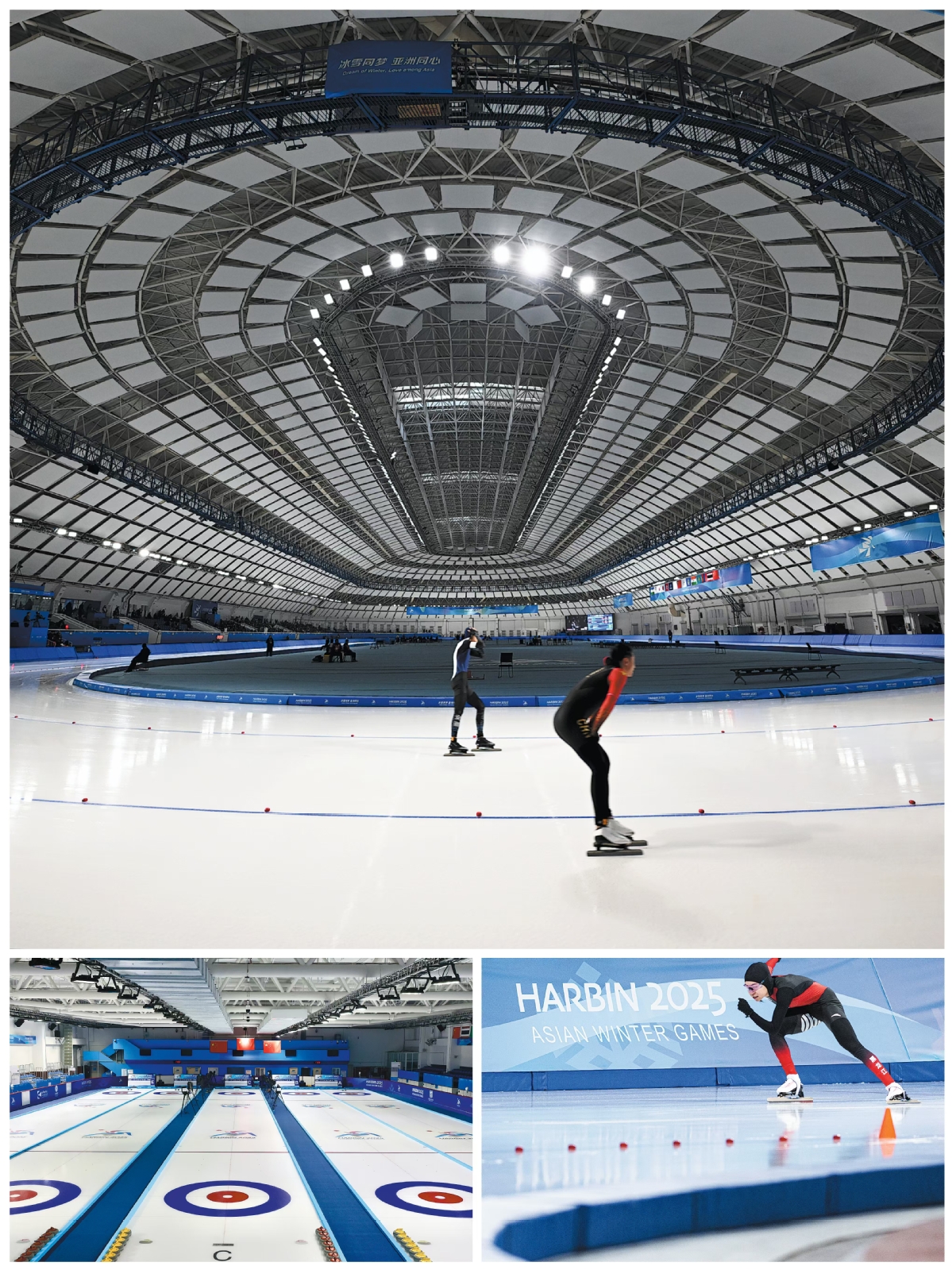
Combining history, technology and local features, Harbin's abundant winter sports venues, with their well-drilled operational staff, have set a dazzling stage upon which Asia's elite winter sports talent can shine.
Known as the cradle of China's Winter Olympians, Harbin is all set to facilitate the best skiers, snowboarders, skaters, curlers and pucksters from across the continent as they push their limits at the 9th Asian Winter Games, which will open on Feb 7 in the Heilongjiang provincial capital.
As the host of all the ice-based sports, Harbin's downtown area has prepared five venues for 32 medal events to be contested in short-track speed skating, figure skating, speed skating, curling and ice hockey, with all the facilities having previously staged domestic and international events in their respective sports.
Since late September, all the five ice sports venues have been tested and optimized, with a series of trial competitions, helping organizers and technical staff fine-tune equipment, lighting, timing and scoring systems, as well as broadcasting and service protocols, to meet the highest international standards.
Scheduled to host three high-profile disciplines — both short- and long-track speed skating and figure skating — the Heilongjiang Provincial Ice Sports Training Center, which consists of two competition arenas and an affiliated training rink, is expected to be the busiest and most popular venue during the Games.
Built in 1983, the centrally located, multifunctional skating hall has been renovated to present short-track speed skating and figure skating to a capacity crowd of around 2,700 spectators. The first gold medal of the Games is very likely to be awarded there in the short-track mixed 2,000m relay on the morning of Feb 8.
The critical transformation between the short-track races and the figure skating program has been tested and perfected through multiple test runs since November, ensuring the competition sessions of both disciplines can take place alternately at the same venue.
"The test events have put our operational staff through real-time drills that emulated everything that will take place during the Games, and challenged our staff with any emergency situations that might arise," said Wang Hua, venue manager of the provincial training center.
"The tests helped us build better coordination and teamwork, and improve our services at the venues."
Another venue in the city's downtown area is the Harbin Ice Hockey Stadium. Built in 1993 to host the third edition of the Asian Winter Games in 1996, it's now set to enjoy an encore by hosting the men's hockey competition at the 2025 edition.
The stadium consists of four standard rinks, including three for training, while accommodating up to 5,500 spectators in the competition hall, based on a total construction area of 32,600 square meters. It's the largest indoor training and competition venue for winter sports in Harbin.
After completing an equipment upgrade and refurbishment in August, as a rehearsal, the stadium hosted the national men's championship in October and earned very positive feedback from athletes and spectators.
"Everything and everyone involved in running competitions here have been tested and examined. The venue's operational team has also built some nice chemistry through the drills, which is quite important for smooth operation during the Games," Li Yutian, a deputy competition director with the Chinese Ice Hockey Association, said of the readiness of the stadium.
To honor its promise of hosting the Games in a sustainable and economic fashion, the Harbin organizing committee borrowed two venues on campus from the Nancheng No 1 Primary School in Pingfang district and Harbin Sport University for hosting the curling and women's hockey tournaments, respectively.
The renovation and staff training at the two venues are expected to continue facilitating the promotion of ice sports among students after the continental gala event is over, organizers said.
Contact the writer at [email protected]
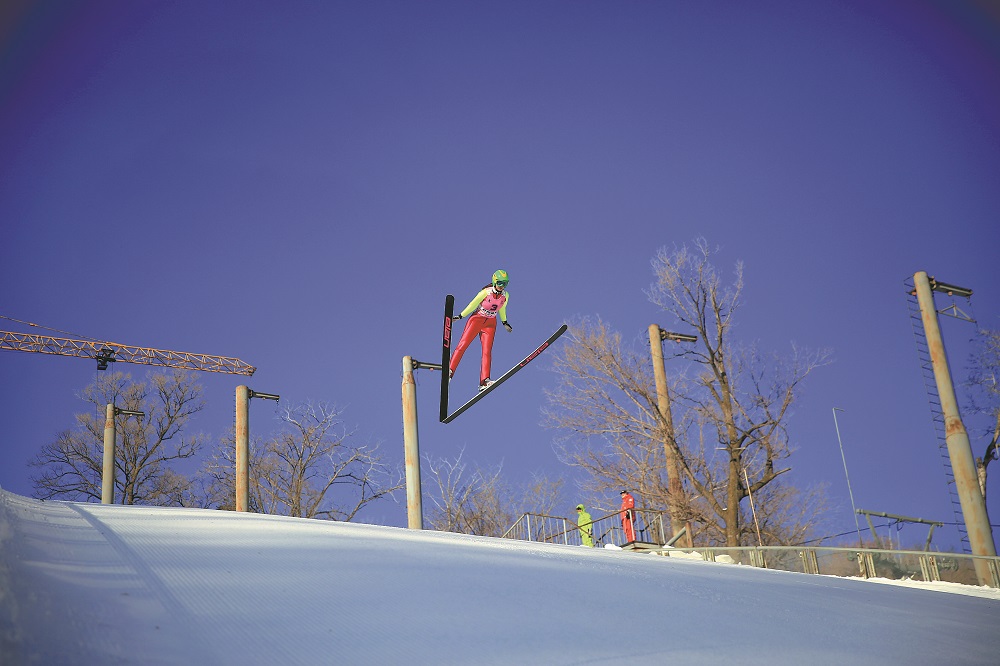
Nearly 200 kilometers from Harbin, the Heilongjiang provincial capital, Yabuli ski resort enjoys up to 170 days of snow a year. It has successfully hosted the 1996 Asian Winter Games, the 24th Winter Universiade in 2009, four National Winter Games, as well as international snow sports events, such as the 2010 Snowboard World Cup, the 2015 Snowboard Junior World Championships, and the 2016 Snowboard World Championships.
At the Harbin 2025 Asian Winter Games, all 32 snow sports medals will be contested in Yabuli across eight venues.
Slopestyle
The recently tested slopestyle venue has been designed with two jump sections and two jib sections — where riders perform tricks on snow surfaces such as rails and boxes.
For the competition, the jumps have a minimum height of 16 meters.
The venue has a total length of 639 m and a width of 40 m. It has a vertical drop of 148 m.
Halfpipe
The halfpipe venue at Yabuli has been fully upgraded for the Harbin Games.
Its vertical drop has been increased to 81 m from 74 m, while the length of its in-run has been extended from 28 m to 34 m. Also, the starting platform has been expanded to 21 m.
The venue now has a length of 286 m, a width of 39 m, and a slope of 18 degrees.
Alpine skiing
The total vertical drop of the alpine skiing venue is 195 m, with a horizontal length of 602 m, an average width of 45 m, and a slope gradient of 18 degrees.
Aerials
After its renovation, the aerials venue now runs a length of 188 m and is 25 m wide. The starting area is 12 m long, the in-run is 88 m with a 25-degree slope. The transition area is 28 m long, the landing slope is 30 m long with a 38-degree slope, and the finish area is 30 m long.
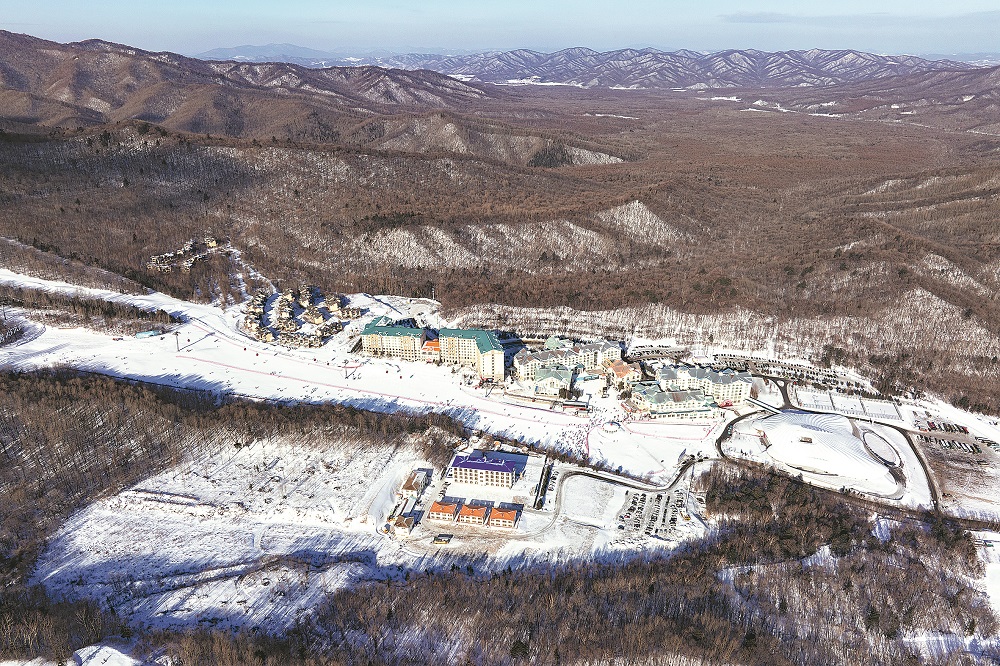
Big Air
The big air venue is divided into five sections: the starting platform, in-run, transition area, landing area and finish area. A 17-meter jump was designed for the event. After detailed planning, the entire Big Air stadium measures 204 m in length and 30 m in width.
The in-run has a vertical drop of 39 m and a slope of 36 degrees, while the landing slope has a vertical drop of 28 m and a slope of 38 degrees.
Biathlon
The main changes to the biathlon venue at Yabuli include a widening of the shooting range, increasing the number of shooting targets to 30, and expanding the radius of several sharp turns. Three courses have been finalized: 2 kilometers, 2.5 km, and 3.3 km, with a total course length of around 5 km and an average course width of eight meters. The penalty loop is 15 m in length, while the shooting range is 89 m long and 50 m wide.
Cross-country
Based on the recommendations from the snow experts and competition managers, four cross-country skiing courses have been finalized: 1.3 km, 2.5 km, 3.75 km, and 5 km. The courses are designed so that one-third features uphill sections, one-third consists of undulating terrain, and one-third includes varied downhill sections.
Ski mountaineering
The ski mountaineering competition, perhaps one of the most anticipated events ahead of its Olympic bow at Milan-Cortina 2026, will utilize the M7 and M8 ski runs at Yabuli. The starting elevation is 580 m, with a track width of 25 to 60 m. The turning point elevation for the short distance M8 course is 650 m, with a vertical gain of 70 m.
For the mixed relay, the turning point elevations for the M7 and M8 courses are 640 m and 650 m, respectively, resulting in a total vertical gain of 130 m.
